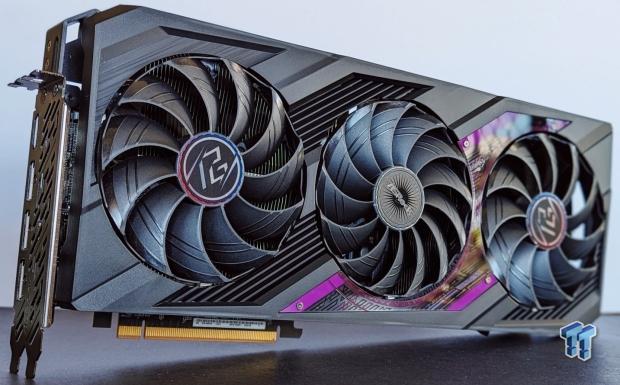
The Bottom Line
Pros
- + Excellent 1440p performance
- + ASRock's Phantom Gaming cooling
- + Competitively priced and great value
- + Gives the GeForce RTX 4070 a run for its money
- + A free copy of Starfield helps sweeten the deal
Cons
- - Ray-tracing performance is still a step behind the competition
- - 4K performance is decent, but there's a sharp drop-off
- - AMD FSR 2 upscaling is not as good as NVIDIA DLSS at 1440p
Should you buy it?
AvoidConsiderShortlistBuyIntroduction
Sometimes, the value proposition can be the deciding factor or thing that pushes a well-designed and high-performing product from one category into the 'must-have' bracket. And that's value in the literal monetary sense, which we highlighted in our review of the AMD Radeon RX 7800 XT Reference model. The USD 499 price point is notably cheaper than NVIDIA's popular GeForce RTX 4070. With similar or slightly better performance in most non-RT-heavy titles, it presents one of the best-value GPUs for the current generation.

Today, we're taking a closer look at the stylish ASRock Radeon RX 7800 XT Phantom Gaming OC model that not only features a surprising and (admittedly cool looking) amount of purple and RGB lighting to match its black casing but with its out-of-the-box overclocking and ASRock cooling it outperforms AMD's reference model while running cooler and quieter. So much so that as much as we like the overall aesthetic of AMD's Radeon RX 7000 Series reference models, something like the ASRock Radeon RX 7800 XT Phantom Gaming OC is a much better choice.
And at the USD 499 price range (give or take in either direction), there's a lot of choice, especially if you're looking for a card that will deliver great 1440p results while offering the option to dip into 4K gaming. Even though the Radeon RX 7800 XT's performance is just about on par with the previous-gen Radeon RX 6800 XT - the lower price-point and RDNA 3 architectural improvements help paint a compelling picture. Let's dig in.

The RDNA 3 Generation
"The world's first chiplet gaming GPU" is how AMD described its new RDNA 3-based GPUs when it lifted the lid on the new Radeon RX 7000 Series. In layperson's terms, the GPU chip isn't just one big square or die anymore, with billions of transistors all arranged in a single layout. Like with its Ryzen CPU range, which embraced chiplet design to great effect (look at how Ryzen has grown in popularity over the years), bringing this design philosophy into the GPU space felt like the natural evolution for AMD's Radeon brand.
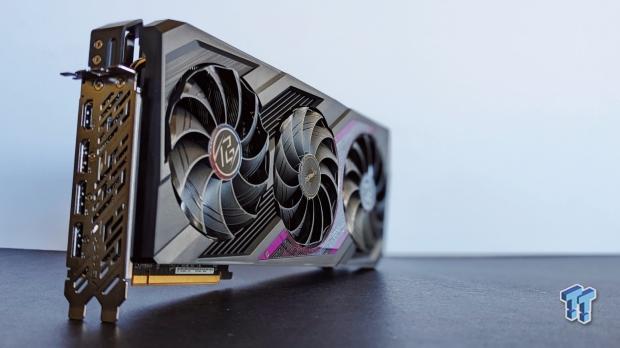
For RDNA 3, what was once a single Graphics Compute Die (GCD) has now split into a GCD plus a Memory Cache Die (MCD). The GCD still makes up most of the hardware grunt and uses the newer 5nm process technology - a step up from RDNA 2's 7nm process. Interestingly, the MCD uses 6nm process technology, which allows AMD to keep costs down as the complexity and cost of manufacturing high-end tech continue to rise.
And to mitigate any performance impact that could arise from going the chiplet route, AMD has also managed to include the "fastest chiplet interconnect in the world," with speeds of 5.3 TB/s. That said, the Radeon RX 7600 entry-level models using the 'Navi 33' GPU follow a more traditional single-chip setup using 6nm process technology to help keep costs down. But with the same RDNA 3 architecture.
AMD's groundbreaking chiplet design can be found in the 'Navi 32' and 'Navi 31' GPUs - Radeon RX 7700 XT, 7800 XT, 7900 XT, and 7900 XTX. AMD's RDNA 3 architecture also features second-generation AMD Infinity Cache, another CPU-like feature designed to boost performance in 1440p and 4K gaming - a "bandwidth amplifier" that sits alongside the GDDR6 memory interface. It helps alleviate the need for more expensive and power-hungry memory buses and is one of those forward-thinking designs we love seeing.
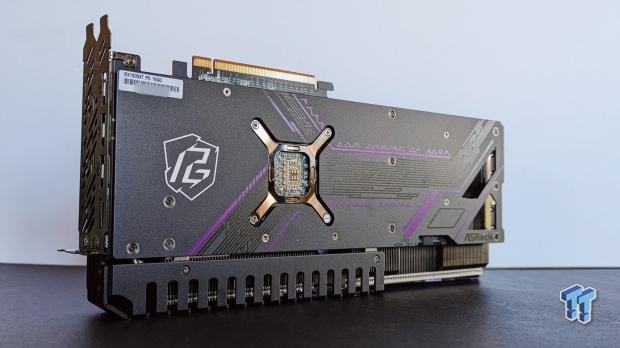
RDNA 3 also represents a significant leap forward for AMD regarding ray-tracing and AI accelerators. RDNA 3 GPUs feature the second generation of dedicated RT hardware and new hardware-based AI acceleration. Real-time ray tracing is hardware intensive; this is one area many were looking for AMD to improve compared to RDNA 2. Which, admittedly, was the company's first attempt at hardware-based ray tracing.
RDNA 3 GPUs are the first graphics cards supporting the new DisplayPort 2.1 spec. The latest DisplayPort interface supports up to 4K 480Hz and even 8K 165Hz, which makes it more of a future-proofing measure than something applicable today. But the real benefit comes with 12-bit HDR support and full Rec2020 coverage for improved color accuracy and detail.
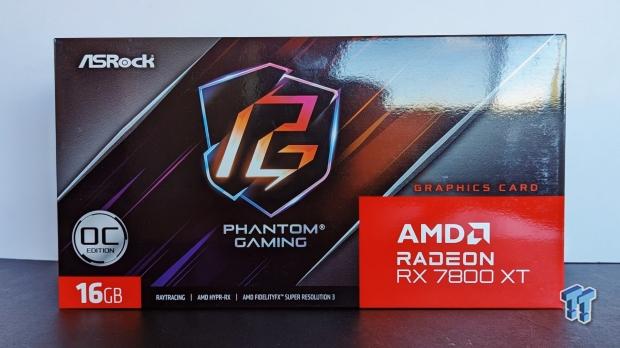
RDNA 3 also introduces hardware-based AV1 encoding to step up its video game for content creators, which means better quality video using the same bitrate. Very cool. For gamers, the introduction of AMD FSR 2 rendering is fully supported here and helps improve performance in intensive games. FSR 2 support might not be as widespread as NVIDIA DLSS, but its addition to games like Cyberpunk 2077 and Starfield is a great sign. Plus, as the tech is fully supported on Xbox Series X|S and PlayStation 5 (with both consoles using AMD graphics hardware), in-game FSR support should grow as time passes.
AMD's DLSS 3-like FSR 3 frame generation technology called 'AMD Fluid Motion Frames' will debut in September 2023 after this review goes live. FSR 3, like FSR 2, will be platform agnostic in that it will work across AMD, NVIDIA, and Intel hardware - but on RDNA 3 and Radeon GPUs, it will take advantage of the new Anti-Lag+ to reduce latency (something NVIDIA alleviates by pairing DLSS 3 with its Reflex latency reduction technology). Ultimately, RDNA 3 is an impressive leap forward for AMD, bringing massive changes to the underlying hardware while delivering a sizable performance leap over the previous RDNA 2 generation.
Specs and Test System
Specifications
Here, we can see how the specs and hardware stack up for the AMD Radeon RX 7700 XT and 7800 XT compares to the previous generation's AMD Radeon RX 6700 XT and 6800 XT.
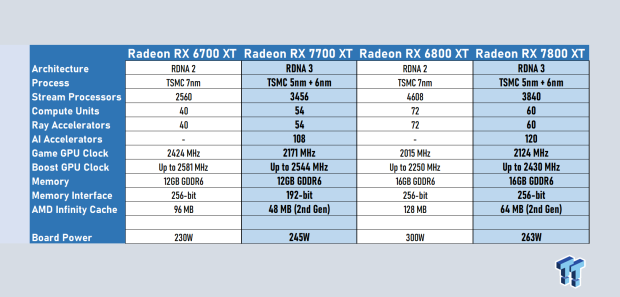
Even though the Radeon RX 7800 XT is the generational successor to the Radeon RX 6800 XT, the new RDNA 3 GPU specifications make it look like a downgrade where you've got a 16.7% reduction in Stream Processor, Compute Unit, and Ray Accelerator counts. Plus, half of the AMD Infinity Cache - 64MB versus 128MB. The only real bump comes in with the overall boost clock speed, and the ASRock Radeon RX 7800 XT Phantom Gaming OC reviewed here pushes the reference figure of 2430 MHz up to a more impressive 2565 MHz.
The jump to RDNA 3 brings a lot to the table, from next-generation RT hardware, creator-friendly features like AV1 encoding and DisplayPort 2.1 to improved Infinity Cache. This means that you're not looking at a like-for-like comparison. And in lowering the cost, with the 6800 XT's launch MSRP of USD 649 dropping to USD 499 with the Radeon RX 7800 XT - you've got a compelling and more efficient version of the Radeon RX 6800 XT.
A generational upgrade that performs the same but is more affordable is hardly exciting, but after a few years of rising prices, it somehow is. The Radeon RX 7800 XT retains its predecessor's 16GB of GDDR6 VRAM on a similar 256-bit interface, making it one of the most powerful and affordable 16GB GPUs in 2023. 16GB of VRAM helps bolster the card's ability to handle almost any game at 1440p and even deliver impressive 4K results depending on the workload.
Throw in the power rating of 263W, and it might not hit NVIDIA levels of power efficiency, but it's a generational step in the right direction.
- GPU: AMD Radeon RX 7800 XT
- Model: ASRock AMD Radeon RX 7800 XT Phantom Gaming 16GB OC
- Interface: PCI Express 4.0
- Stream Processors: 3840
- Compute Units/Ray Accelerators/AI Accelerators: 60/60/120
- Clock Speeds: Boost Clock: Up to 2565 MHz, Game Clock: 2254 MHz
- Memory: 16GB GDDR6
- Memory Speed: 19.5 Gbps
- Memory Interface: 256-bit
- Display Connections: 1 x HDMI 2.1, 3 x DisplayPort 2.1
- Power Connectors: 2 x 8-pin
- Total Board Power: 263W
- What's in the Box: ASRock AMD Radeon RX 7800 XT Phantom Gaming 16GB OC, Quick Installation Guide
Kosta's Test System
- Motherboard: MSI MPG X670E Carbon Wi-Fi
- CPU: AMD Ryzen 9 7900X
- Cooler: Corsair iCUE H100i RGB PRO XT Liquid CPU Cooler
- RAM: 64GB (2x32GB) Corsair DOMINATOR PLATINUM RGB DDR5 DRAM 5200MHz
- SSD: Sabrent Rocket 4 Plus-G M.2 PCIe Gen 4 SSD 4TB, Sabrent Rocket 4 Plus M.2 PCIe Gen 4 SSD 8TB
- Power Supply: Thermaltake Toughpower GF1 850W
- Case: Thermaltake Core P3 Tempered Glass Snow
- OS: Microsoft Windows 11 Pro 64-bit
Physical Design and Cooling
With a metal backplate, reinforced metal frame, ample heat pipes, and a triple-fan cooling setup, ASRock's Phantom Gaming design is structurally sound, quiet, and cool. With dimensions of 328 x 140 x 53mm and a weight of 1450g, it's not as compact as AMD's reference model, but the thickness stays below the 3-slot threshold, where case compatibility can become a problem.
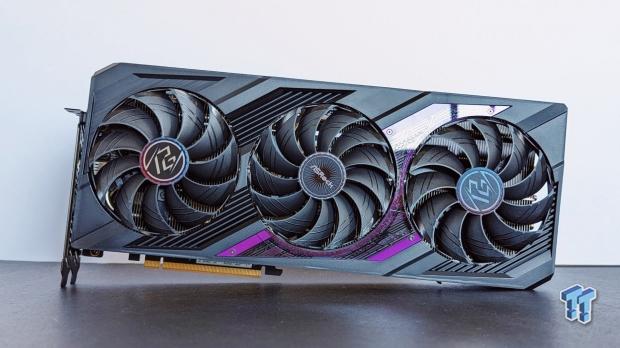
ASRock's Phantom Gaming 3X Cooling System is one we've experienced a few times in the past and have always walked away impressed, and that's still the case here. The Phantom Gaming range presents one of the more premium variants from the company. Here, you've got great touches like a center fan that spins reverse to enhance airflow through the GPU, 0dB Silent Cooling that stops fans when the card is idle or not breaking a sweat, and a nickel-plated copper base to maximize the GPU contact area.
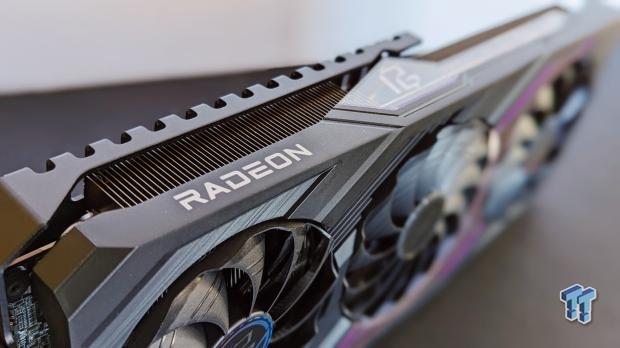
The result is a Radeon RX 7800 XT model that runs substantially cooler than AMD's reference design and quieter. The overall physical design adds to the card's impressive performance, which features several purple flourishes and RGB strips to deliver a unique look when the card is up and running. Blue and other neon RGB colors make the purple accents pop, making it one of the more stylish Radeon GPUs we've tested. And for those that want to minimize the light show, ASRock includes a handy LED on and off switch on the GPU itself, which is very cool.
Benchmarks - 15 Game Averages
The Games and Tests
In 2023, PC gaming is a complicated and varied space, from indie games to major blockbuster releases and titles that push hardware and technology to their limit with the adoption of effects like real-time ray-tracing.
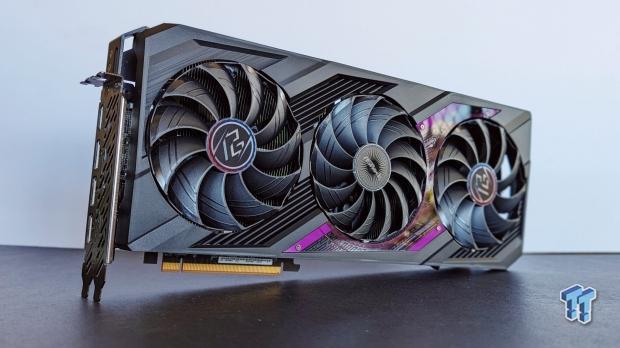
This is all a way of saying that the 15 in-game benchmarks we've chosen (run at 1080p, 1440p, and 4K) represent a wide range of styles, not only in terms of genres, like first-person shooters and racing games, but also in the API technology (DirectX 11, 12) and cutting-edge features like ray tracing and upscaling technology.
Results include DLSS and FSR 2, where possible, as both technologies are the sorts of things, especially in 1440p and 4K, which you'd turn on. Six of the 15 game benchmarks also feature ray tracing. Also, each title is set to ultra-equivalent quality settings to push GPU hardware and minimize CPU bottlenecks at higher resolutions.
Also, it's just fun to max out a game's visual settings and see the results. Here's the breakdown of games, graphics settings, and what's being tested.
- Assassin's Creed Valhalla: Ultra High-quality settings, with the in-game benchmark tool used.
- Borderlands 3: Ultra quality settings, with the in-game benchmark tool used.
- Call of Duty: Modern Warfare II: Ultra quality setting, in-game multiplayer benchmark tool used. AMD FSR 2 and NVIDIA DLSS results are included.
- Cyberpunk 2077: Ultra quality setting, in-game benchmark tool used. AMD FSR 2 and NVIDIA DLSS results are included.
- Cyberpunk 2077 (RT): Ray tracing Ultra quality setting, in-game benchmark tool used. AMD FSR 2 and NVIDIA DLSS results are included.
- DOOM Eternal (RT): Ultra Nightmare quality setting with ray-tracing enabled, the opening of Mars Core campaign level used to benchmark. NVIDIA DLSS results included.
- F1 22 (RT): Ultra High-quality setting with ray tracing, one lap of the Bahrain track benchmarked. AMD FSR 2 and NVIDIA DLSS results are included.
- Forza Horizon 5 (RT): Extreme quality setting with ray tracing enabled, in-game benchmark tool used. AMD FSR 2 and NVIDIA DLSS results are included.
- Hitman (RT): Ultra-quality settings with ray-tracing, Dubai scene benchmarked. AMD FSR 2 and NVIDIA DLSS results are included.
- Horizon Zero Dawn: Ultimate quality setting, in-game benchmark used.
- Marvel's Guardians of the Galaxy (RT): Ultra quality setting with ray tracing enabled, the in-game benchmark tool used. NVIDIA DLSS results included.
- Rainbow Six Extraction: Ultra quality settings and in-game benchmark tool used. NVIDIA DLSS results included.
- Red Dead Redemption 2: Maximum quality settings, with in-game benchmark tool used. AMD FSR 2 and NVIDIA DLSS results are included.
- The Division 2: Ultra quality settings with in-game benchmark tool used.
- Total War: Warhammer III: Ultra-quality settings with the in-game Battle Benchmark tool used.
15 Game Average FPS - 1080p Results
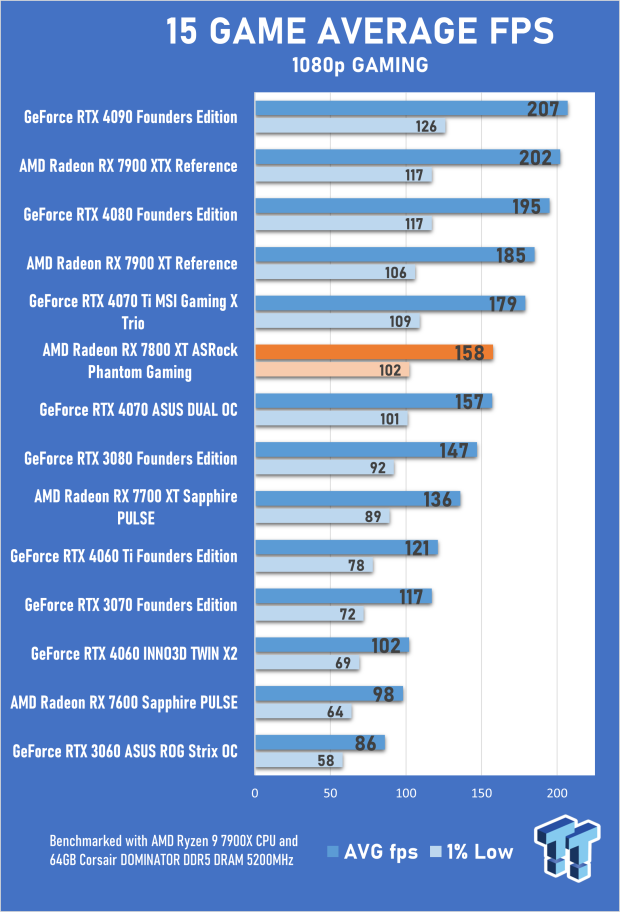
With our 15-game benchmark suite featuring a mix of games, including a batch of titles with ray-tracing, the overall performance of the Radeon RX 7800 XT compared to the GeForce RTX 4070 from NVIDIA makes the two cards look interchangeable. The difference at 1080p is 0.6% in favor of the Radeon RX 7800 XT (specifically the overclocked ASRock Radeon RX 7800 XT Phantom Gaming OC reviewed here), with that growing to 4% at 1440p.
The real story is a lot more nuanced than this, and there's a lot of back and forth from title to title - with the ASRock Radeon RX 7800 XT Phantom Gaming OC falling behind mostly in titles that feature a heavy dose of real-time ray-tracing like Cyberpunk 2077. At 1080p with the RT Ultra settings enabled in Cyberpunk 2077, the GeForce RTX 4070 is a whopping 40% faster than the Radeon RX 7800 XT. Turn off ray-tracing and run Cyberpunk 2077 using the game's Ultra quality mode, and the ASRock Radeon RX 7800 XT Phantom Gaming OC performs 18.7% faster than the GeForce RTX 4070.
And there are examples like Call of Duty: Modern Warfare II, where this lead increases even further. However, the ASRock Radeon RX 7800 XT Phantom Gaming OC is more suited to 1440p - so let's jump into those results.
14 Game Average FPS - 1440p Results
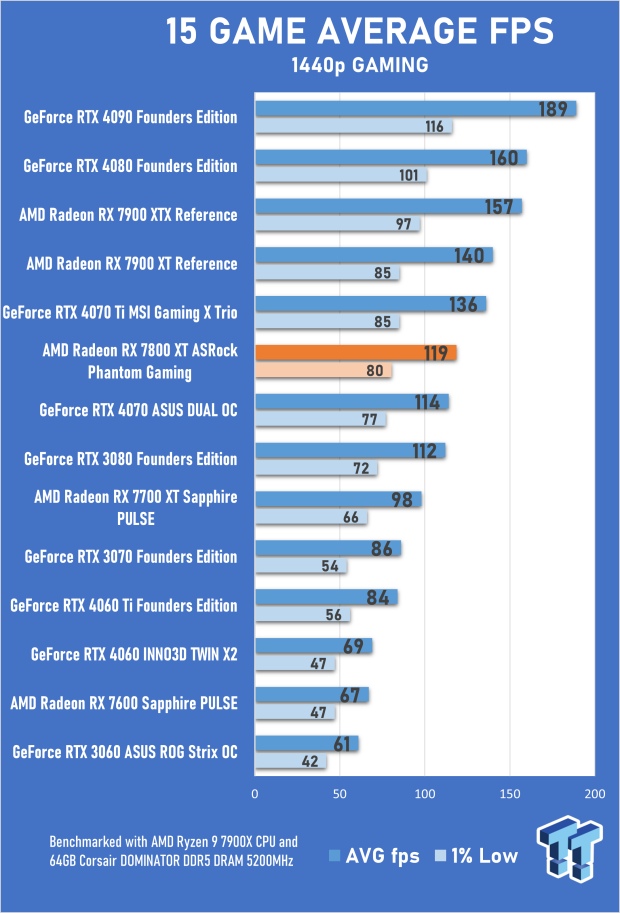
Across 15 games, the ASRock Radeon RX 7800 XT Phantom Gaming OC delivers an average frame rate of 119 fps and a 1% low average of 80 fps when gaming at 1440p. The triple-digit average makes it a powerhouse at this resolution, especially when playing games without ray-tracing. It's a result that also makes the Radeon RX 7800 XT, with its MSRP of USD 499, look like a better deal than the Radeon RX 7700 XT, with its MSRP of USD 449 - because you're looking at a 21% increase in overall performance. Of course, as a premium model, the ASRock Radeon RX 7800 XT Phantom Gaming OC commands a higher price, though it's close enough.
Here, the ASRock Radeon RX 7800 XT Phantom Gaming OC maintains a small lead over the GeForce RTX 4070, delivering a 4% increase in performance. Again, this varies wildly from title to title, and the card's ray-tracing performance at this resolution is a definite step down from NVIDIA's offering - something to consider if you're interested in that sort of thing. This isn't to say that RT performance on the ASRock Radeon RX 7800 XT Phantom Gaming OC is bad - games like DOOM Eternal, F1 22, and Forza Horizon 5 deliver very playable results at 1440p with RT enabled.
It's also a trade-off because you've got titles like Call of Duty, where the new RDNA 3 architecture outperforms GeForce hardware by a sizeable amount. Though, for the most part, when you take away the RT heavy and Call of Duty exceptions, performance between these two GPUs is very similar. You're looking at GeForce RTX 3080 and Radeon RX 6800 XT-like performance at this resolution.
15 Game Average FPS - 4K Results
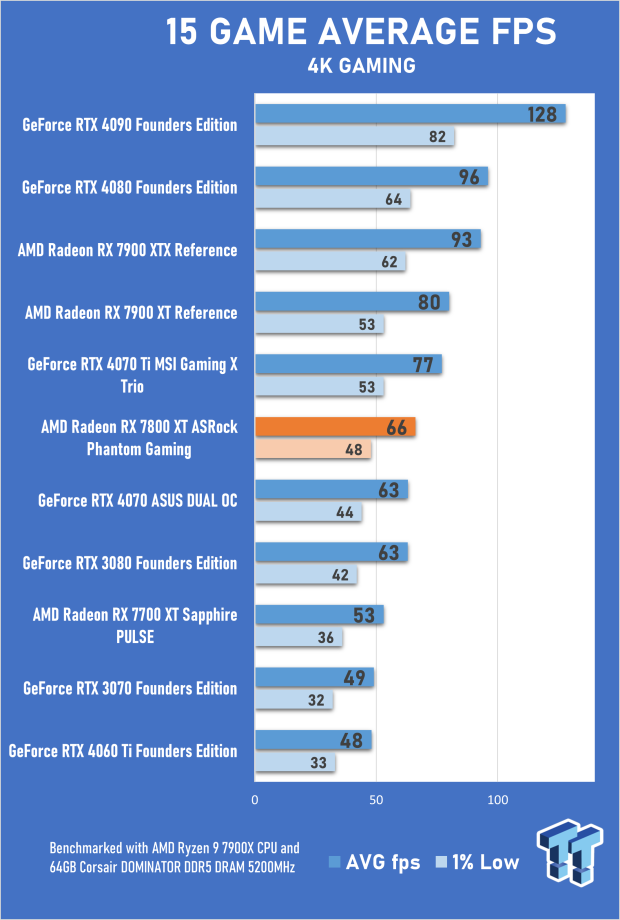
A few years ago, 60fps became the gold standard for what you'd consider super-fast performance for a PC title. Recently, this has become 100+ fps, where the increase in performance is noticeable, and improved frame times are a godsend for competitive titles where twitch-like reaction times can decide between victory or being called a noob. This is a roundabout way of saying that yes, the ASRock Radeon RX 7800 XT Phantom Gaming OC is a capable 4K performer, especially when you include FSR 2 upscaling to boost those fps numbers without sacrificing too much in the way of visual fidelity.
It will depend on the game, the visual settings, and other elements. The Radeon RX 7800 XT features 16GB of VRAM, ready for 4K. However, the performance drop-off from 1440p to 4K for the ASRock Radeon RX 7800 XT Phantom Gaming OC sits at around 44.5%, which is enough to consider it a 1440p card first and foremost. At 4K, the ASRock Radeon RX 7800 XT Phantom Gaming OC's lead over the GeForce RTX 4070 increases slightly to 4.8% while its lead over the Radeon RX 7700 XT grows to 24.5%.
Benchmarks - 3DMark FireStrike
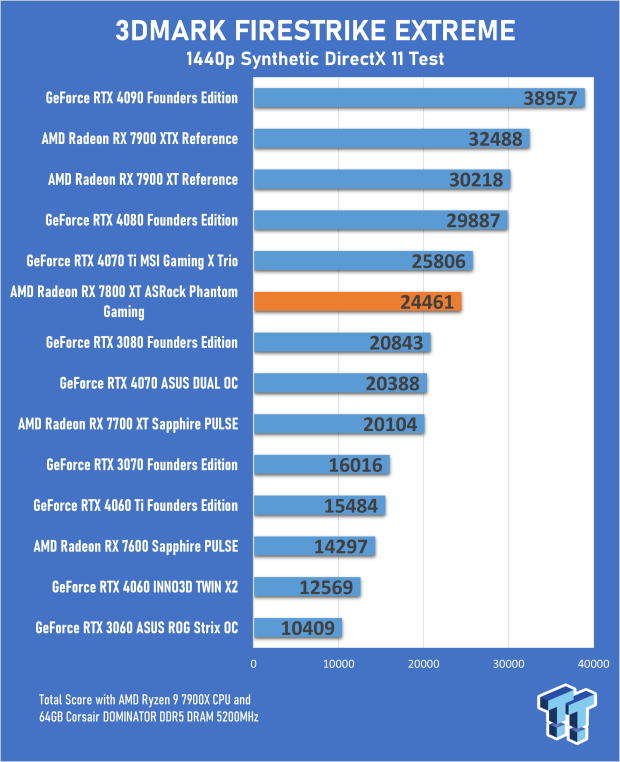
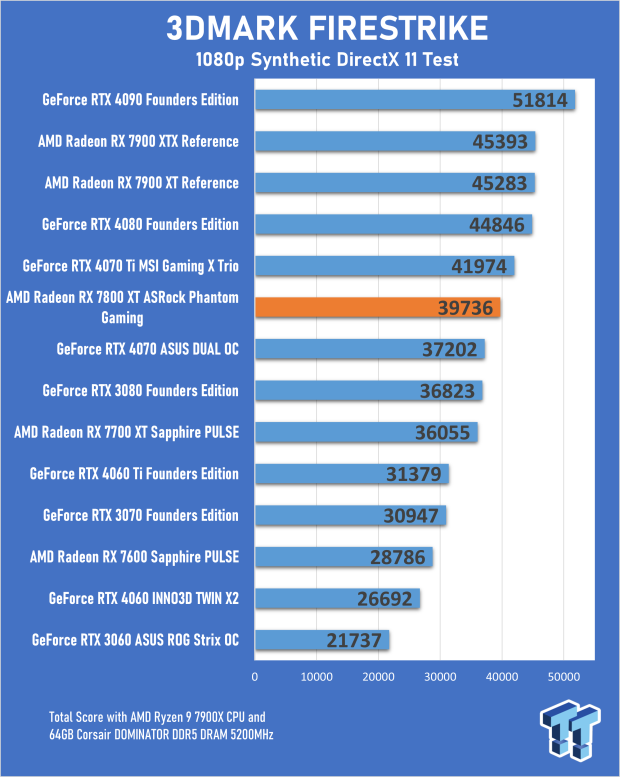
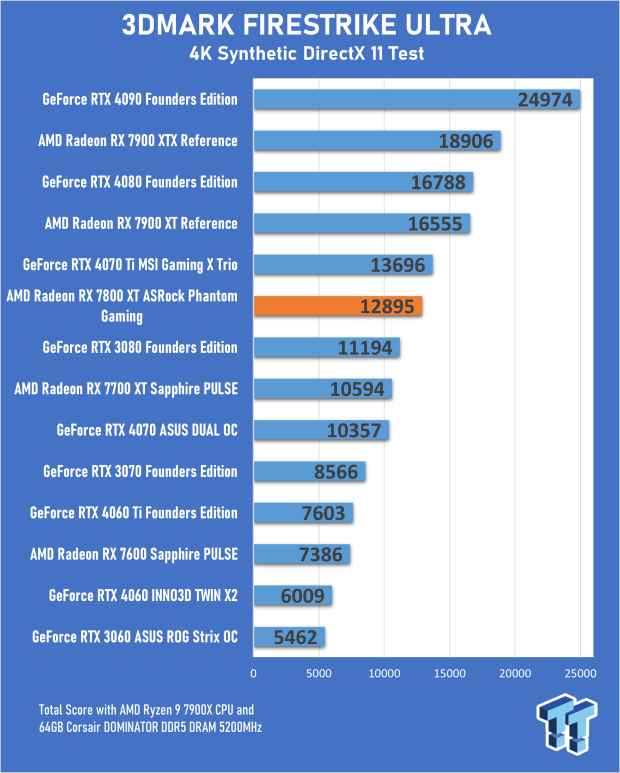
3DMark FireStrike is a DirectX 11 test that has been around for several years; it covers quite a large portion of games released over the past decade regarding the API and graphics technologies used. The three tests cover the resolutions - 1080p, 1440p, and 4K. The 1440p Extreme test is the one highlighted above, and as a synthetic benchmark, it shows that the ASRock Radeon RX 7800 XT Phantom Gaming OC delivers a score roughly 20% higher than the GeForce RTX 4070 and its RDNA 3 sibling, the Radeon RX 7700 XT.
Per the in-game benchmark results above, it's not a result reflected in actual in-game tests outside of a few exceptions. So, this is probably a case of FireStrike being a more favorable AMD benchmark than one indicative of raw performance.
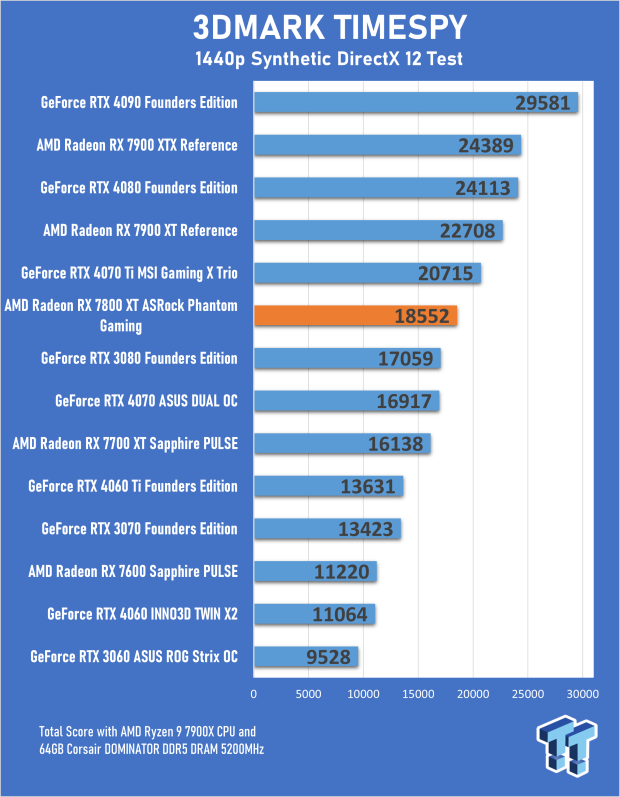
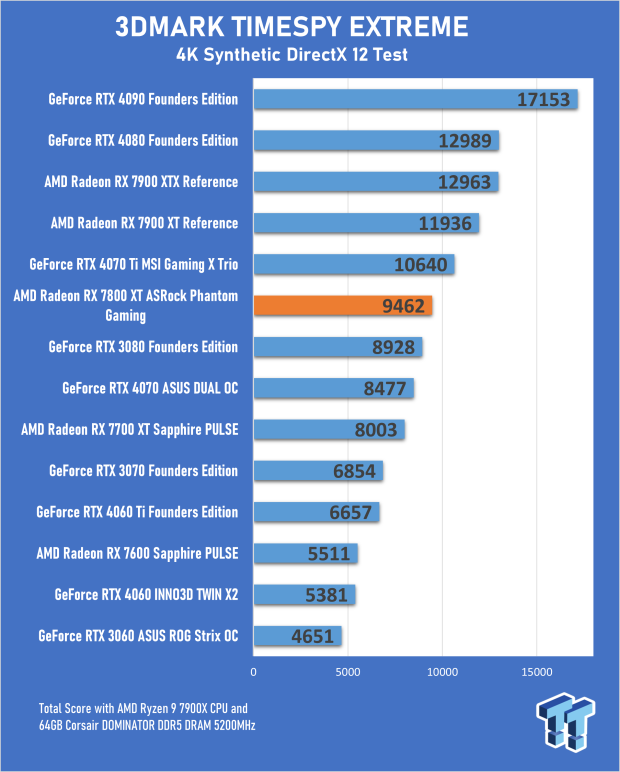
With 3DMark TimeSpy being DirectX 12-based, it's a more relevant synthetic benchmark for modern games. Here, we see results that more closely match the in-game benchmarks, with the ASRock Radeon RX 7800 XT Phantom Gaming OC's 1440p score 15% higher than the Radeon RX 7700 XT and 9.7% higher than the GeForce RTX 4070. It's not quite indicative of in-game performance, but it's close enough to showcase that the Radeon RX 7800 XT is generally faster than the GeForce RTX 4070 regarding non-ray-traced gaming.
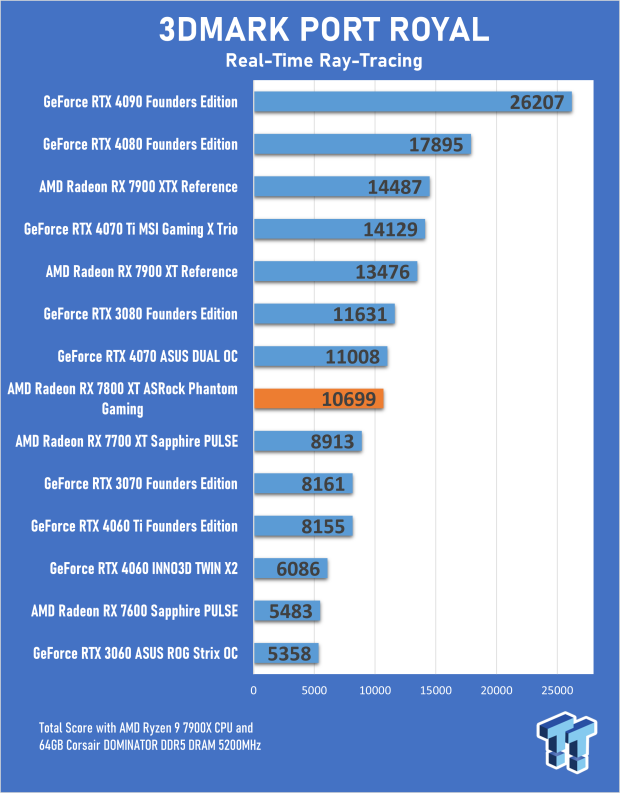
The ASRock Radeon RX 7800 XT Phantom Gaming OC's ray-tracing performance is not as impressive as what the new GeForce RTX 40 Series GPUs are capable of (especially regarding the additional benefits of DLSS 3.5 and Frame Generation), but it's certainly ready for RT. 3DMark Port Royal is a synthetic ray-tracing benchmark, and surprisingly, the Radeon RX 7800 XT delivers a score close to the GeForce RTX 4070 - it's only 2.8% lower.
This is why the card stays competitive in titles like Forza Horizon 5, where only a few RT effects are going on - though it does begin to fall apart when you look at RT-heavy experiences like Cyberpunk 2077 and Hitman. AMD's FSR 2 certainly helps, but at 1440p, the Radeon RX 7800 XT's ray-tracing limit (mostly), image quality is a step behind NVIDIA's DLSS.
Benchmarks - 1080p Gaming
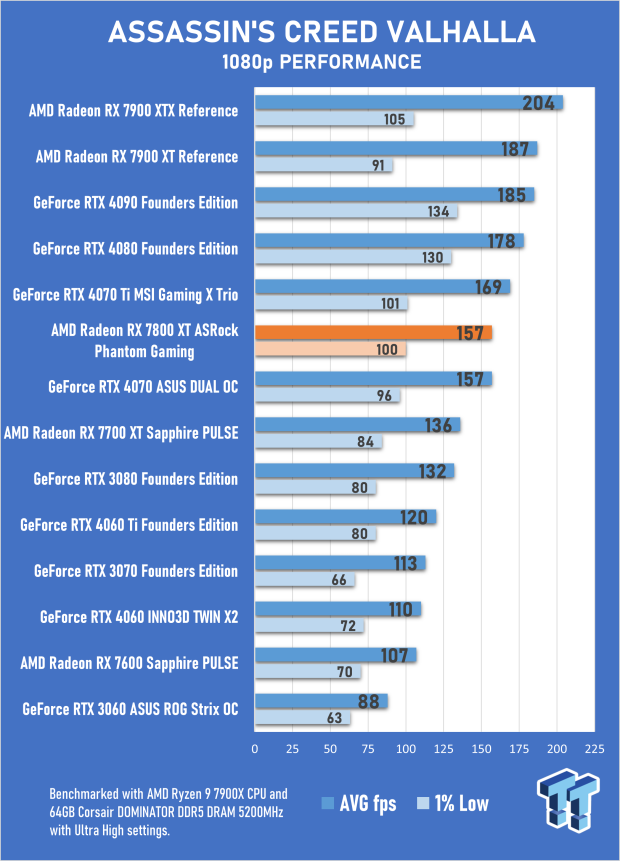
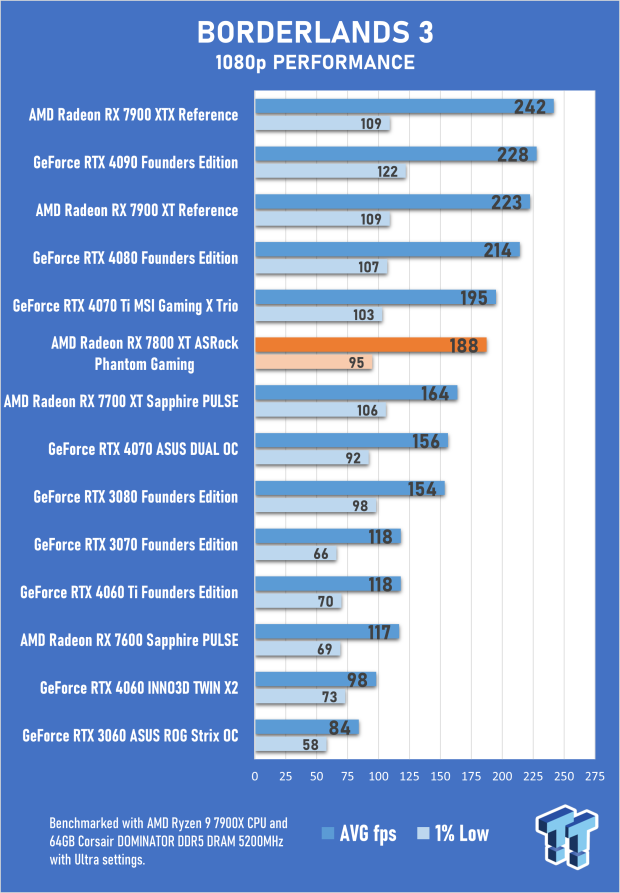
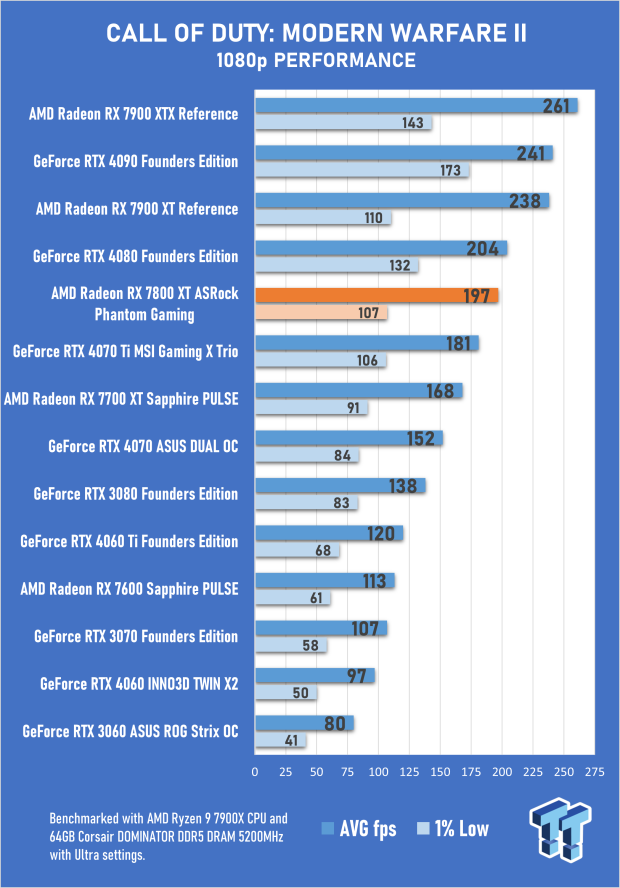
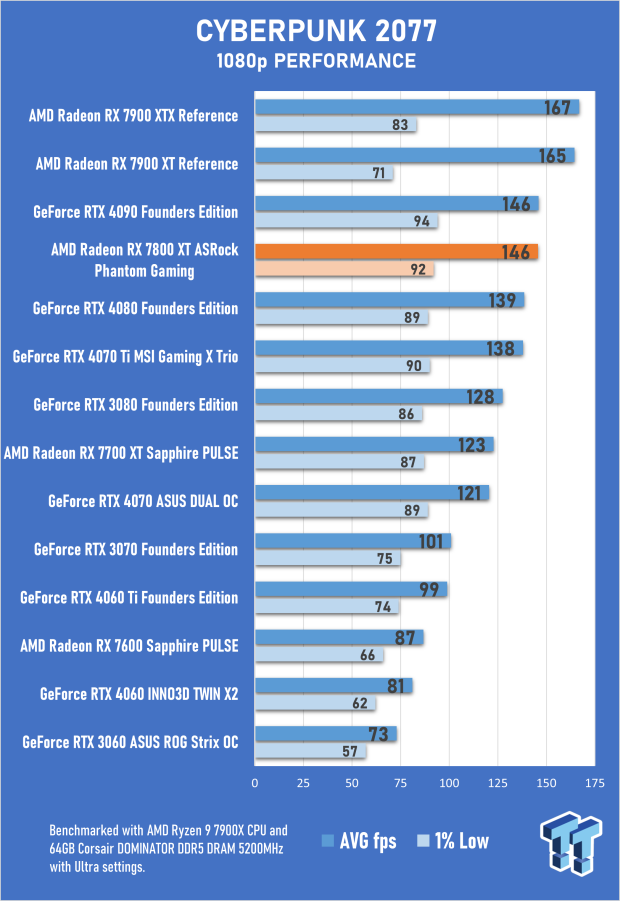
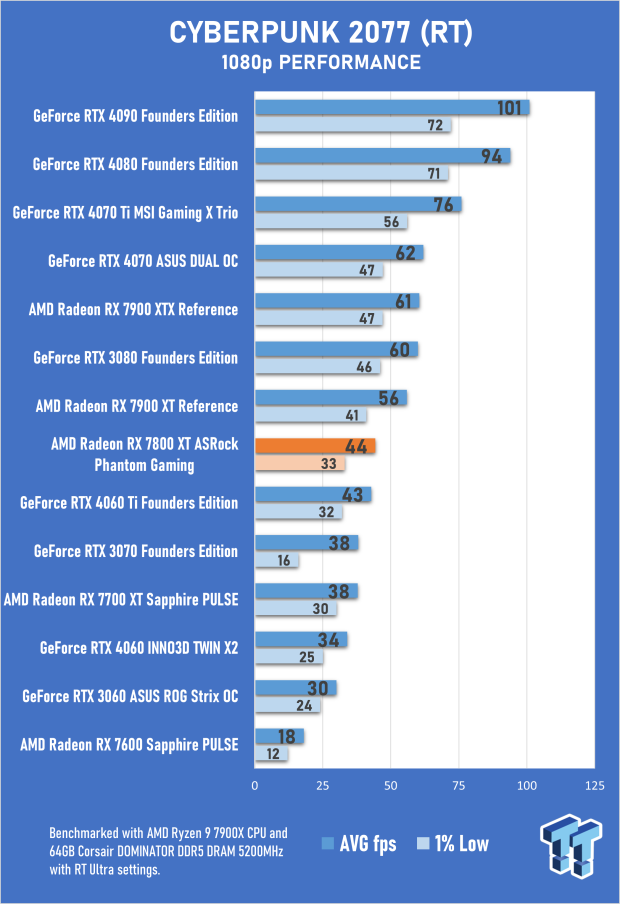
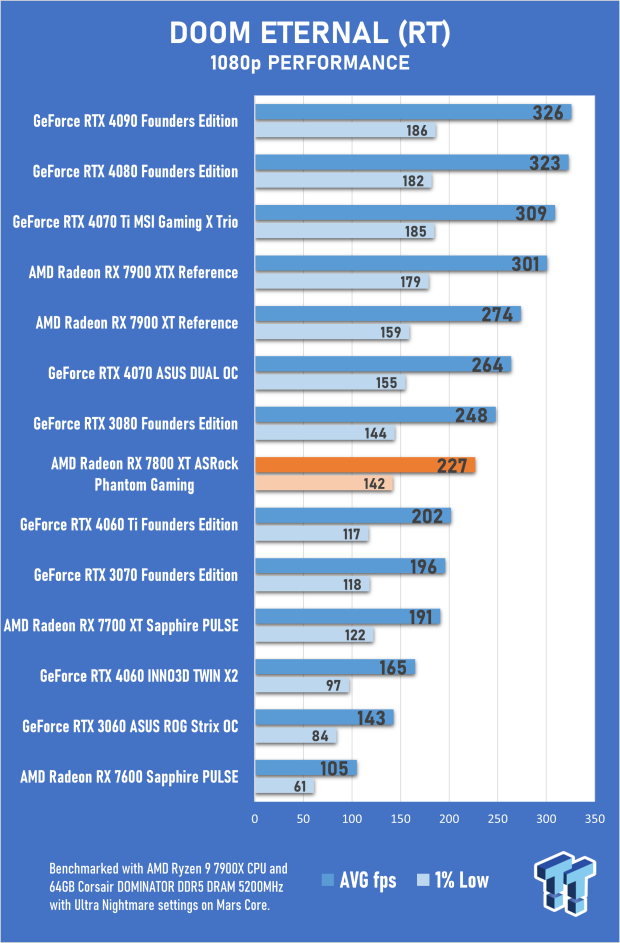
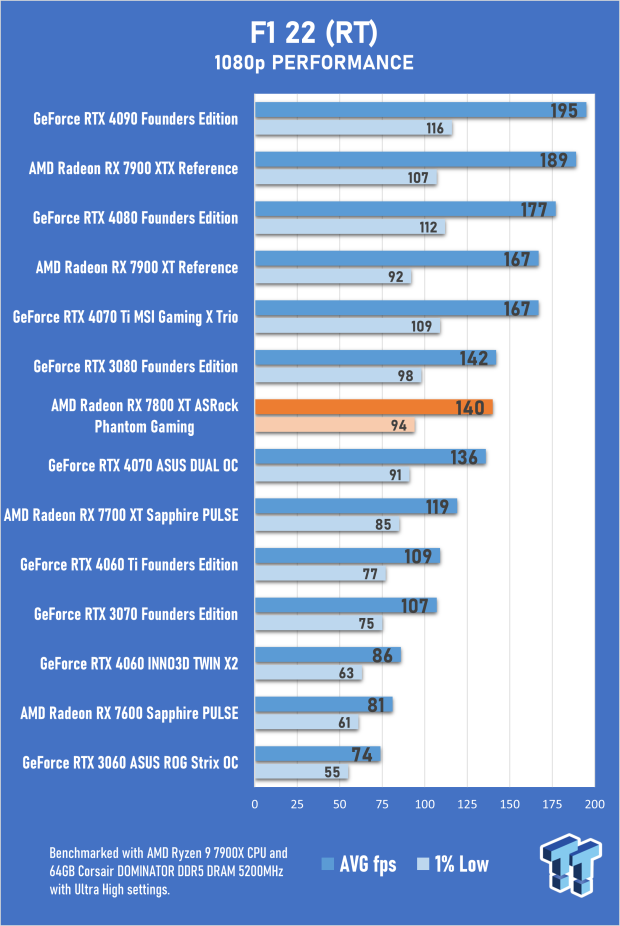
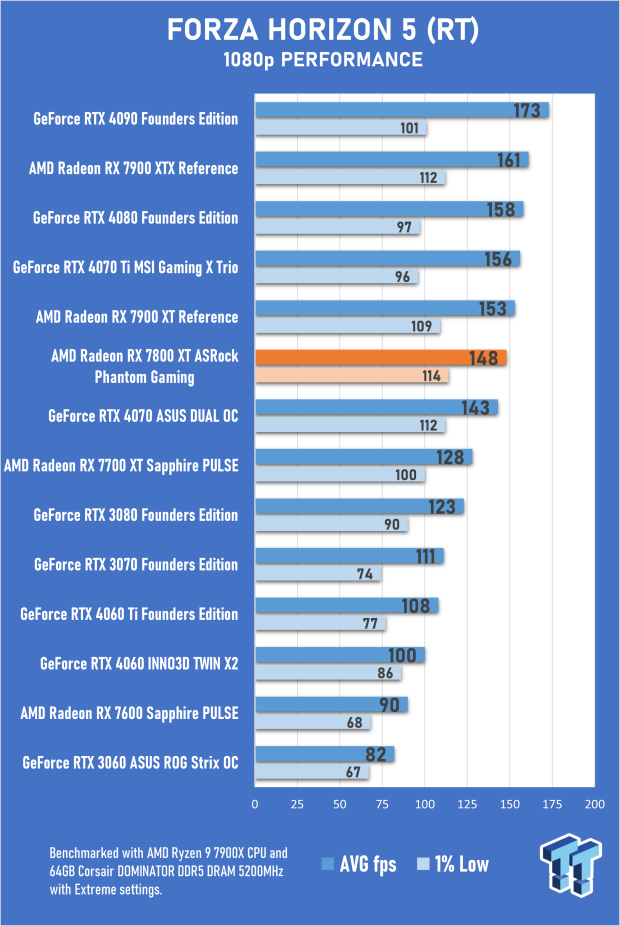
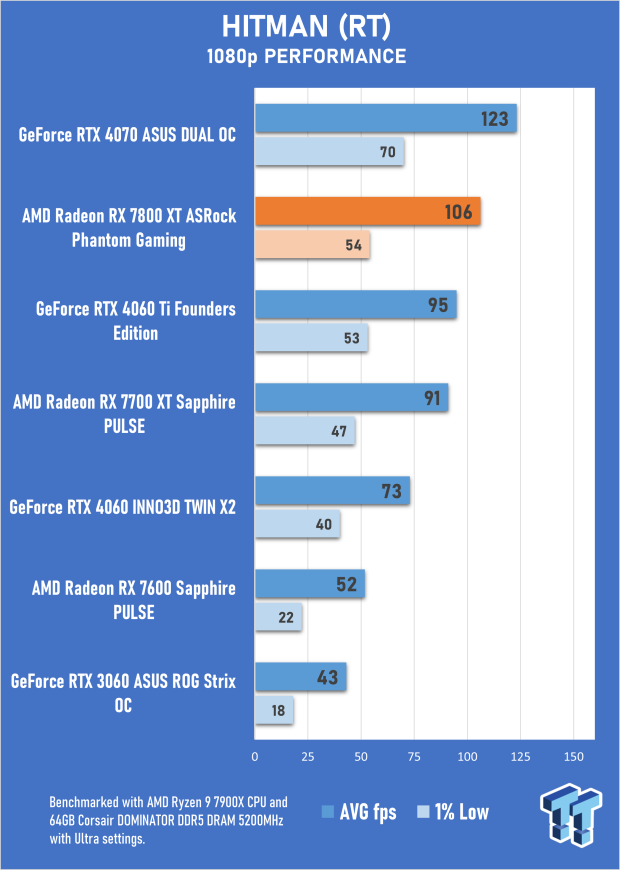
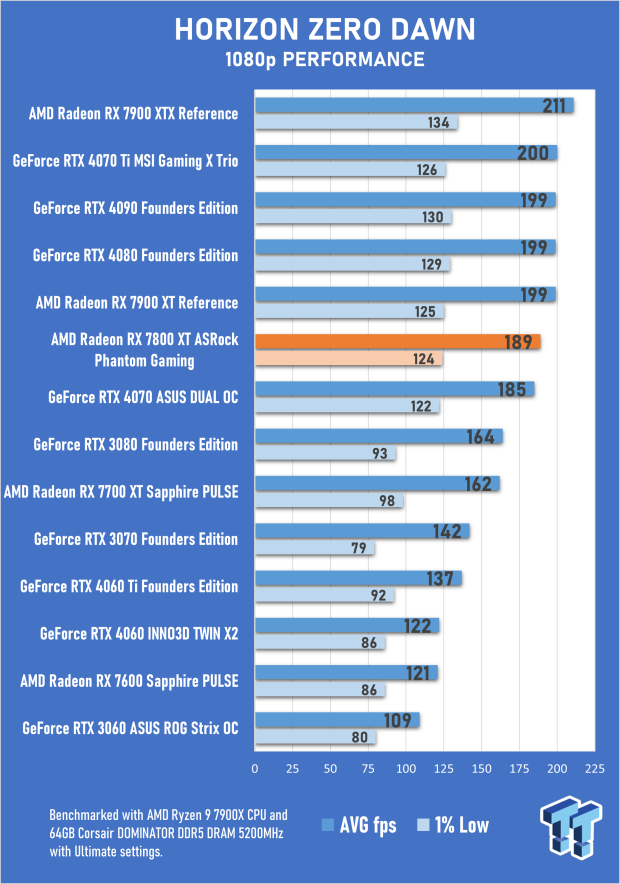
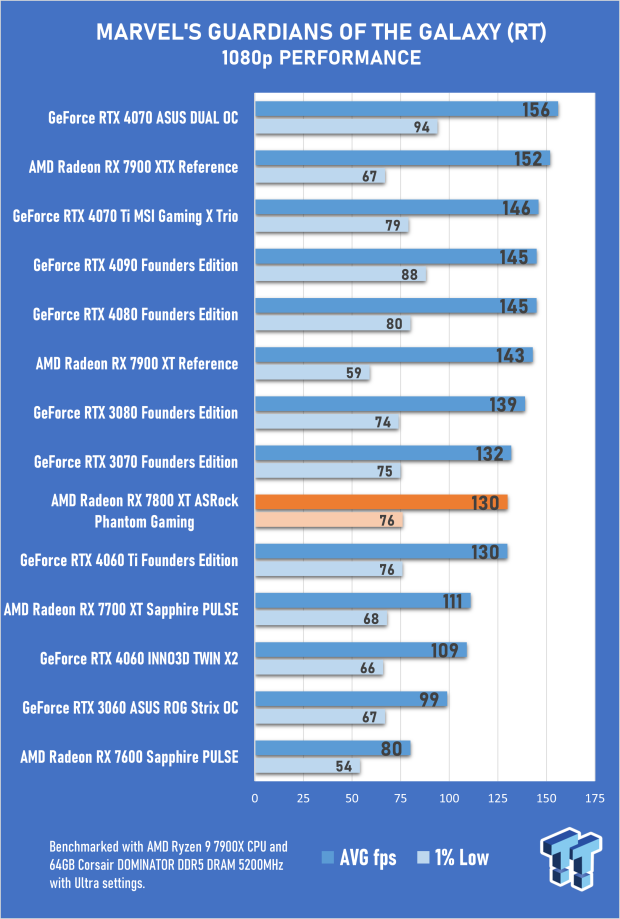
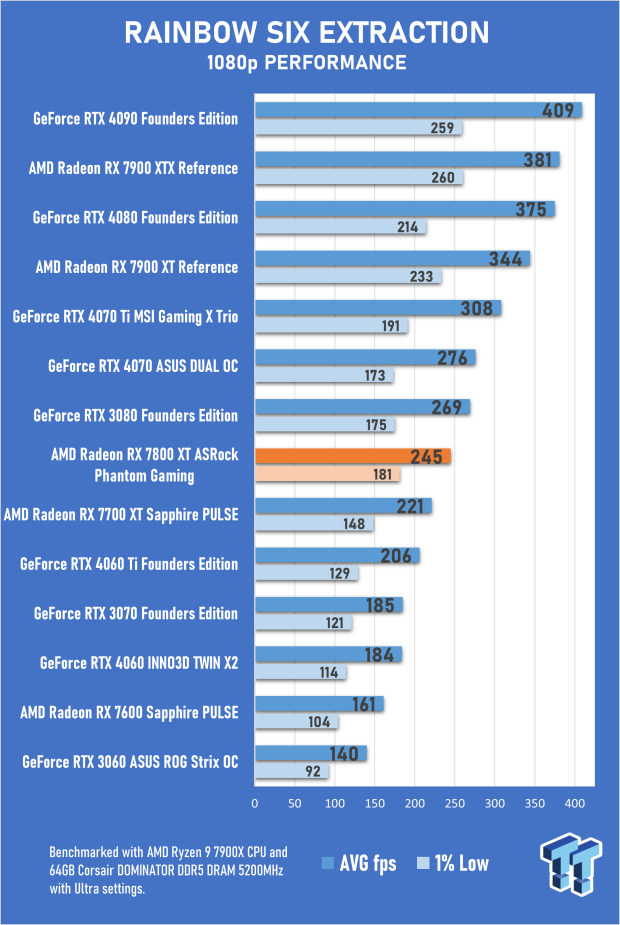
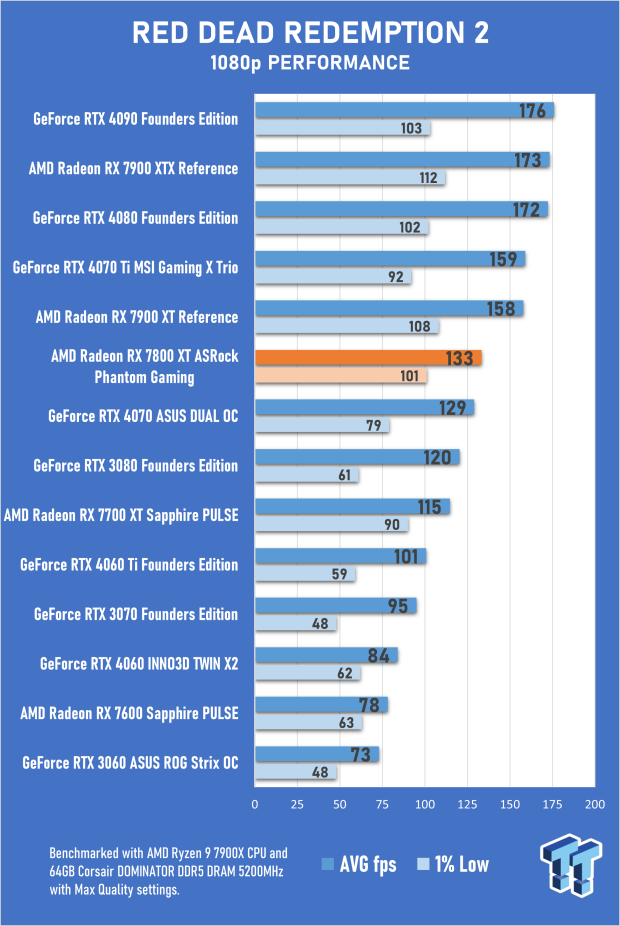
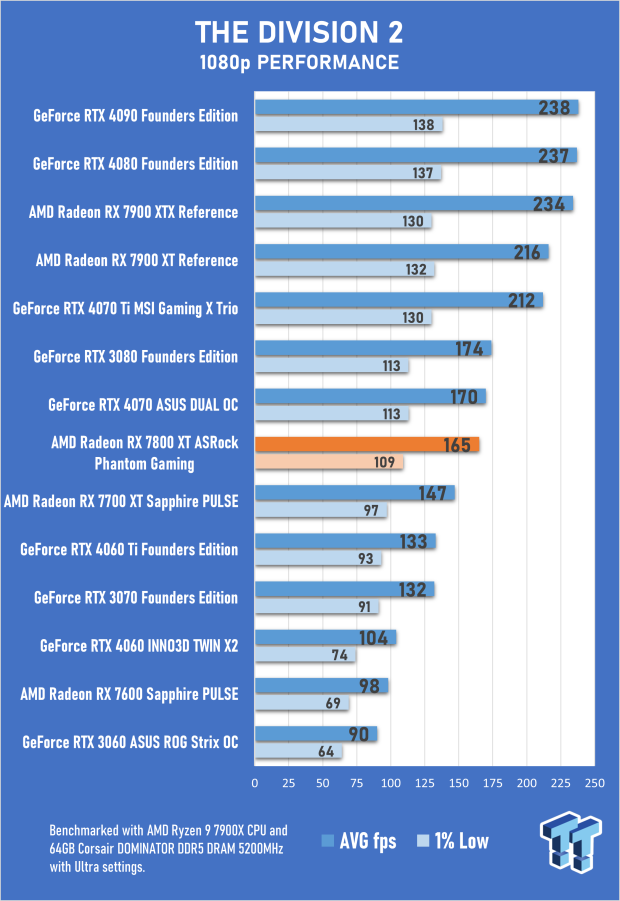
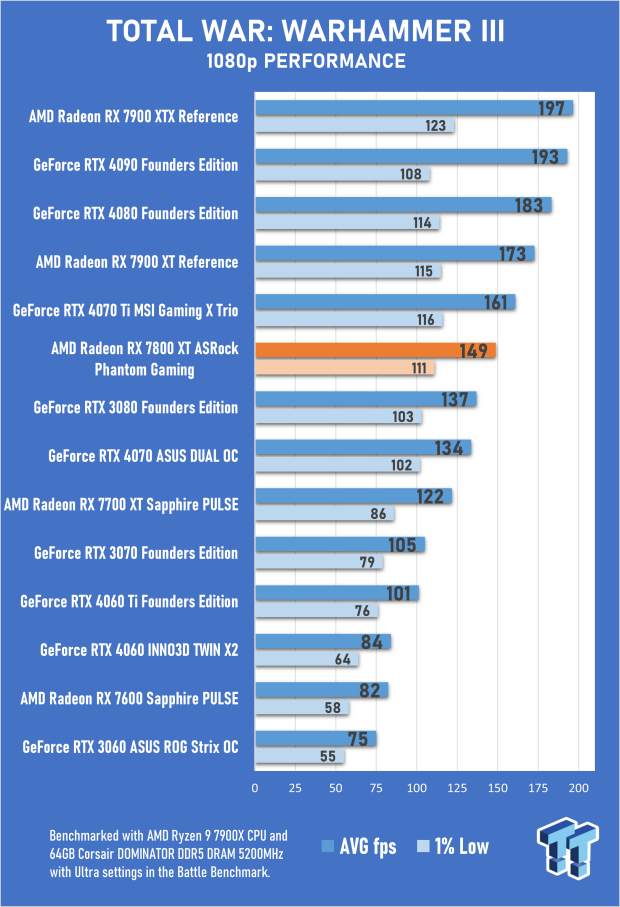
Benchmarks - 1440p Gaming
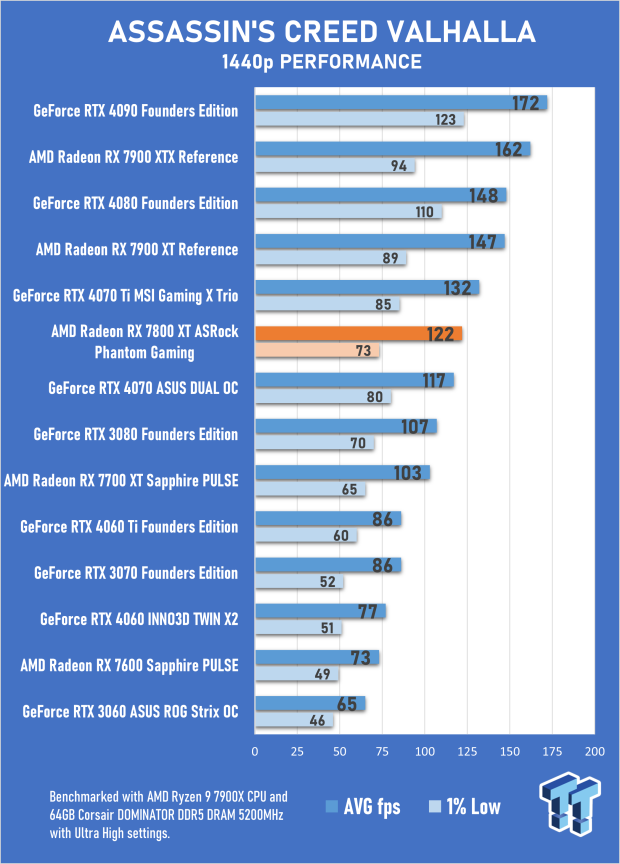
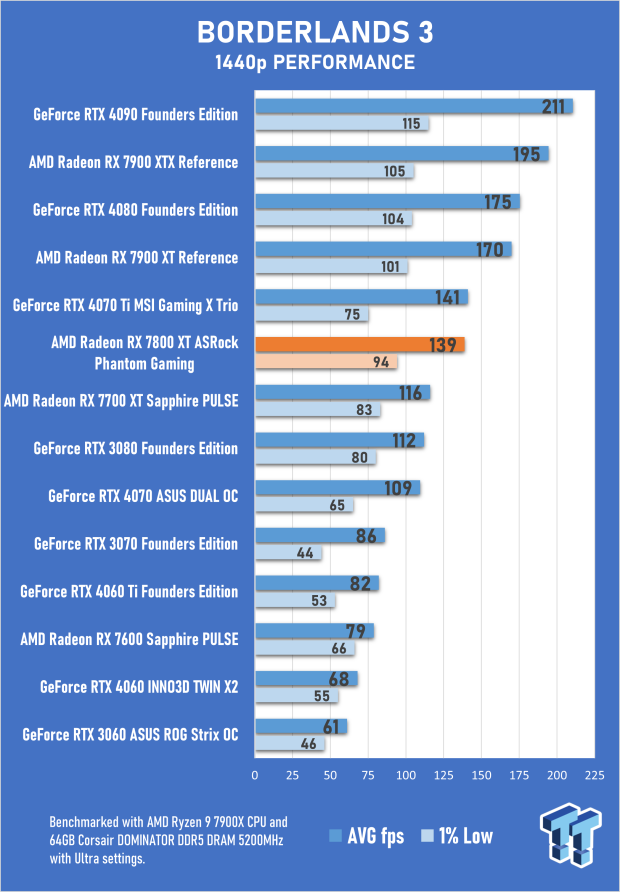
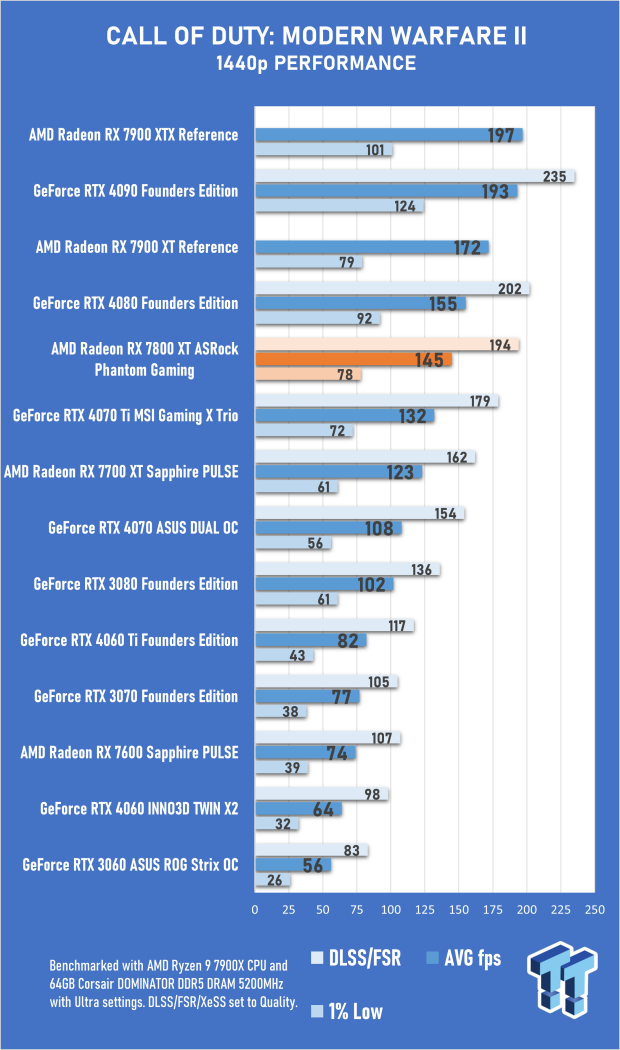
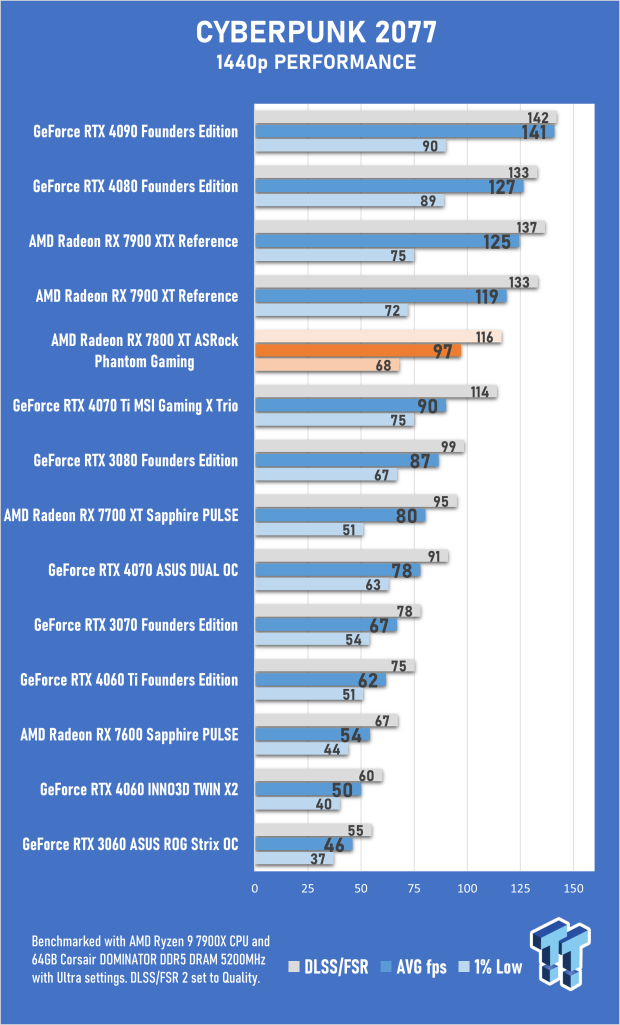
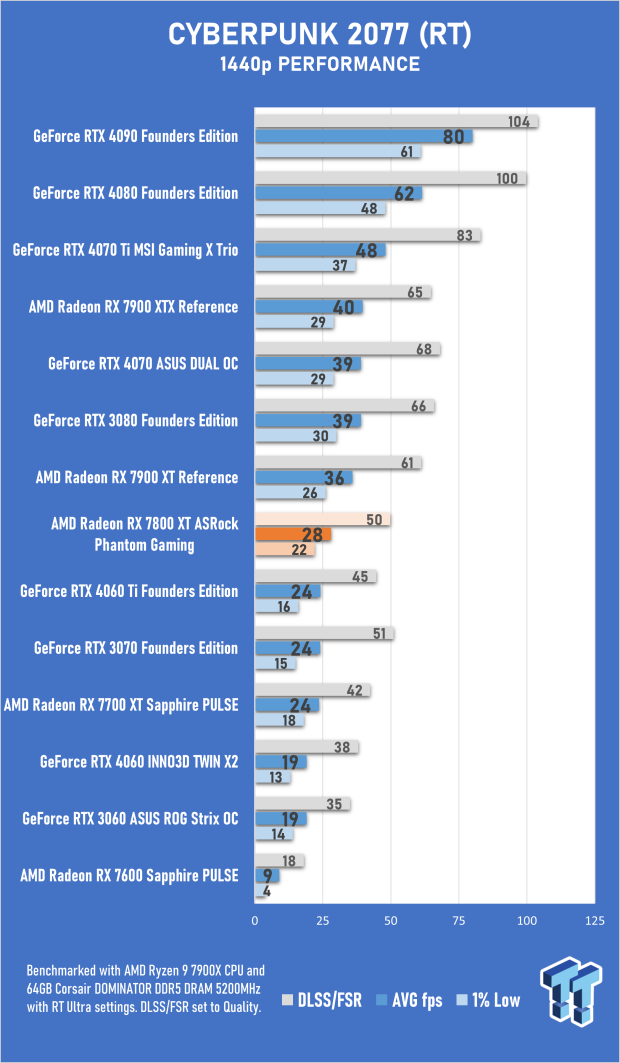
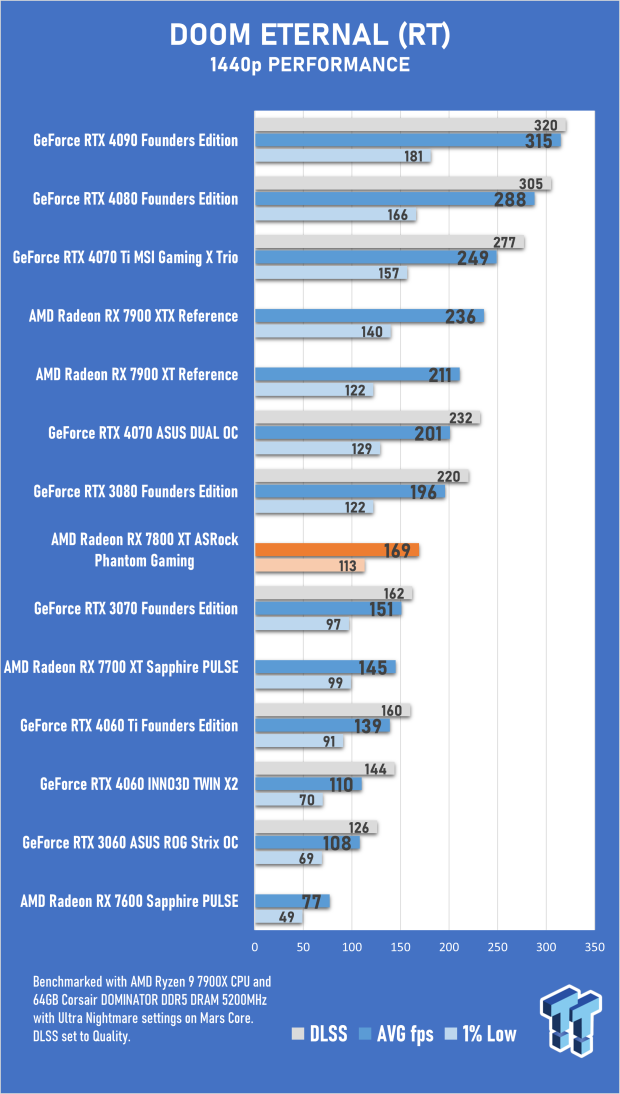
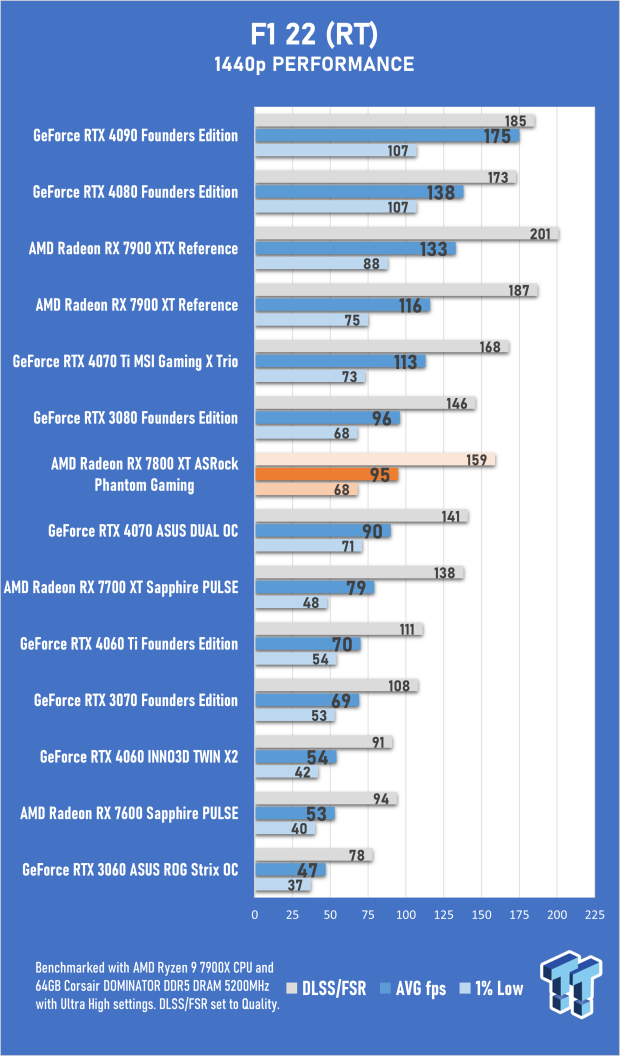
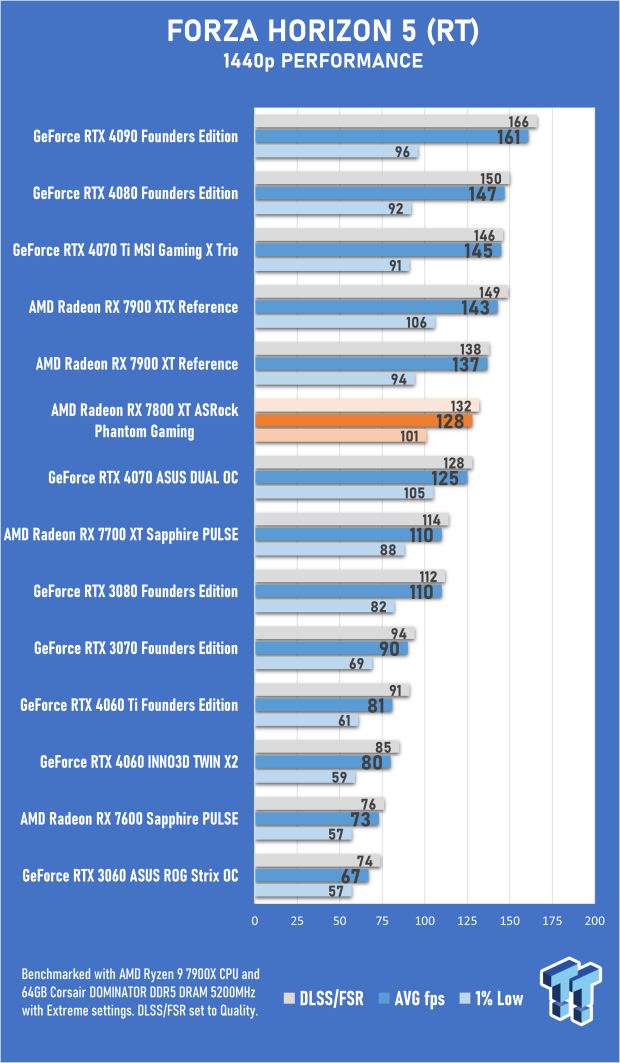
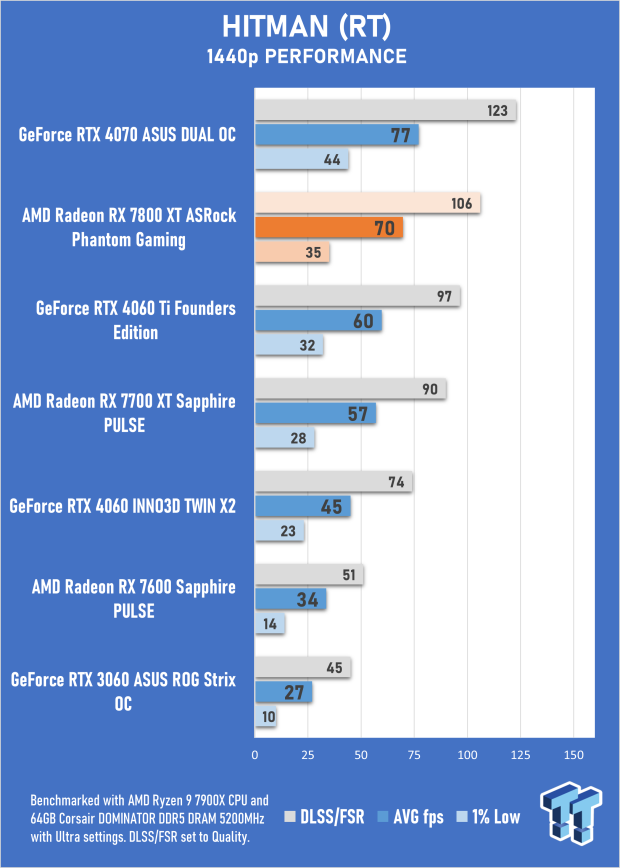
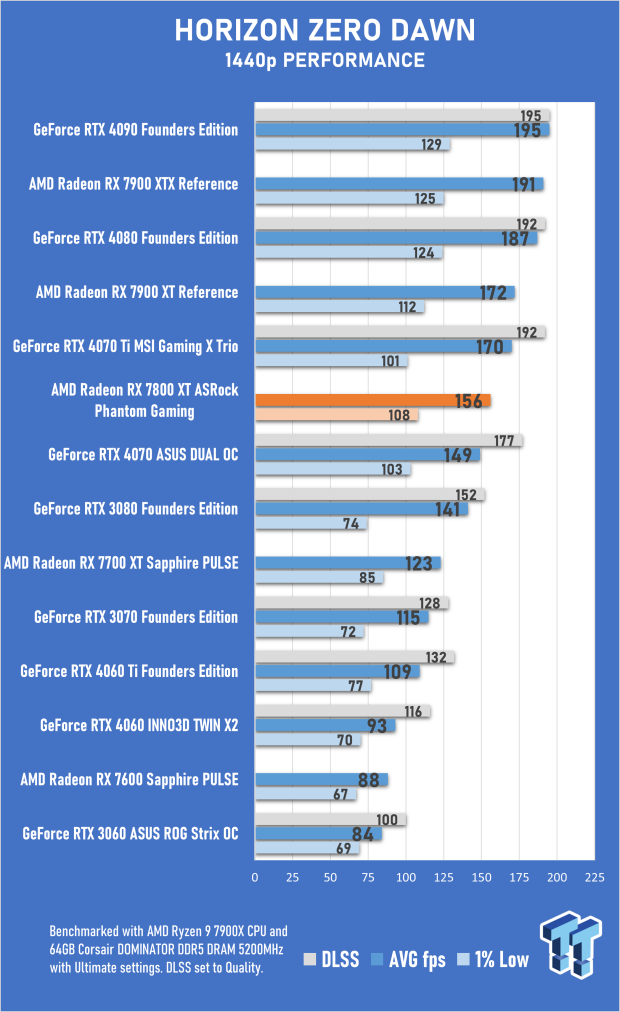
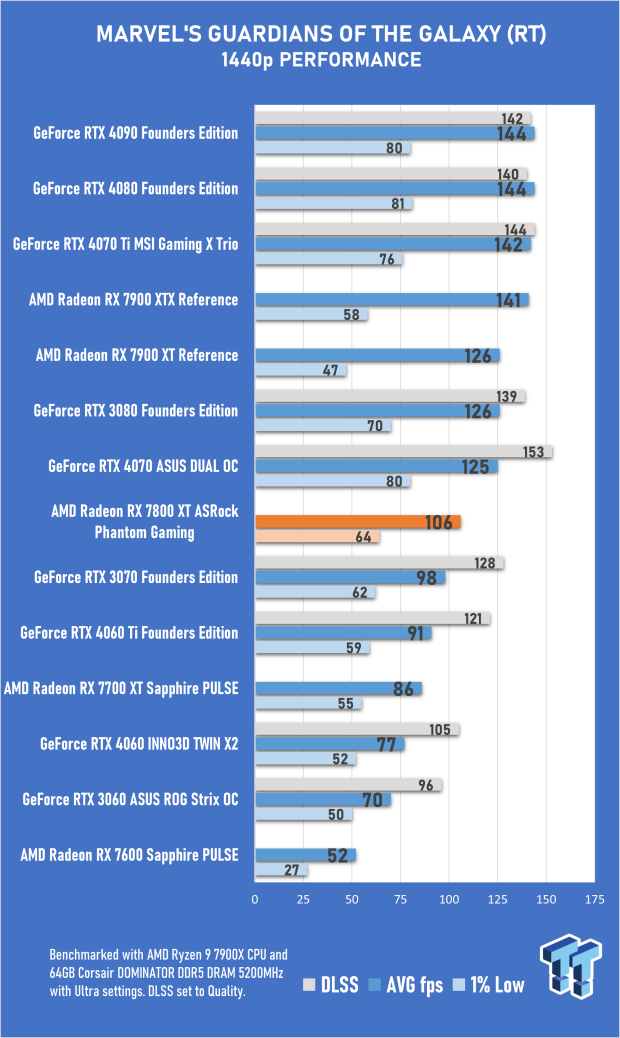
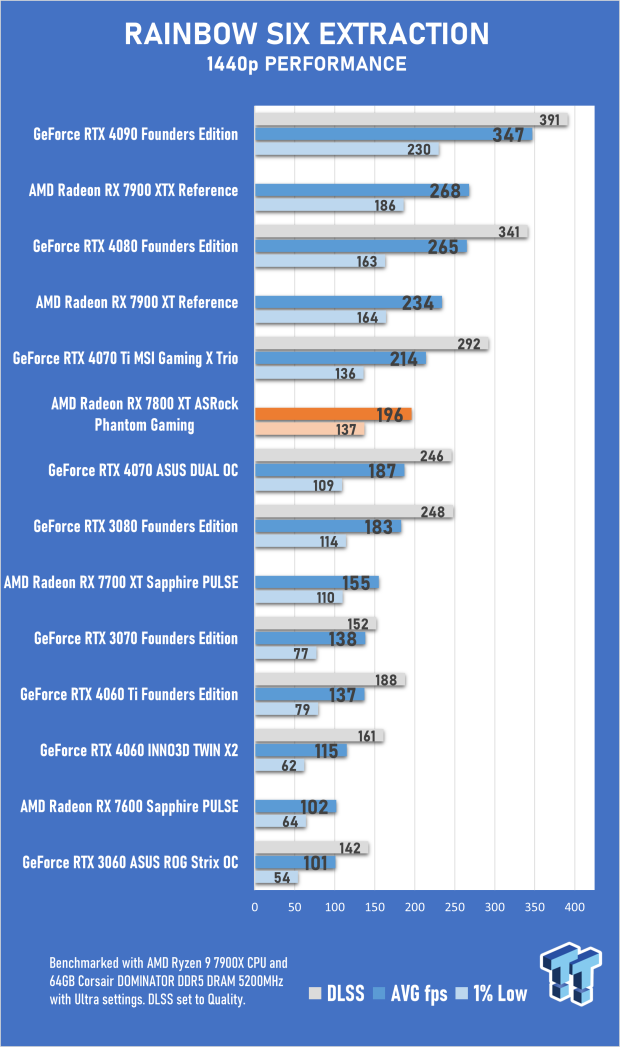
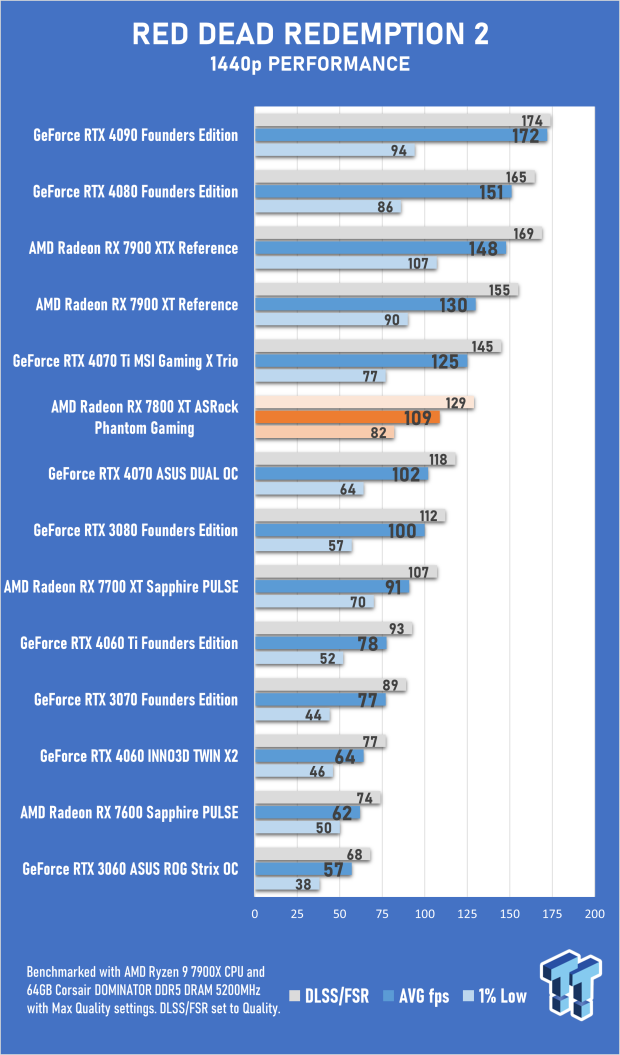
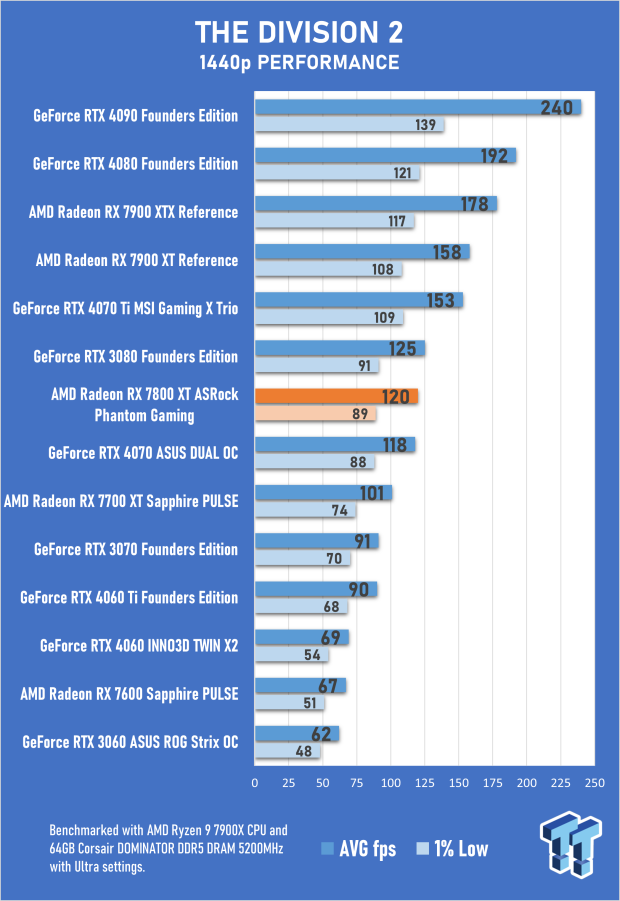
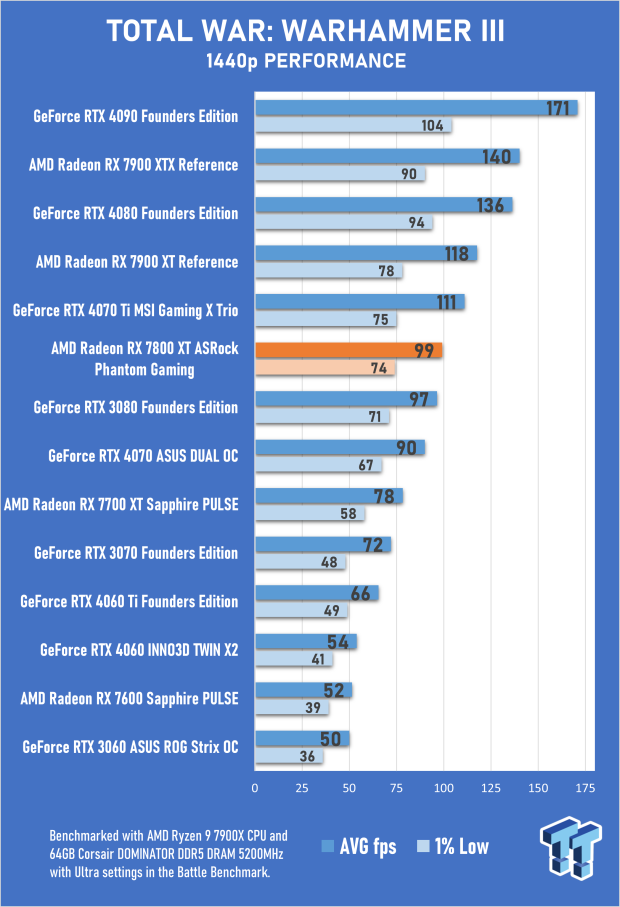
Benchmarks - 4K Gaming
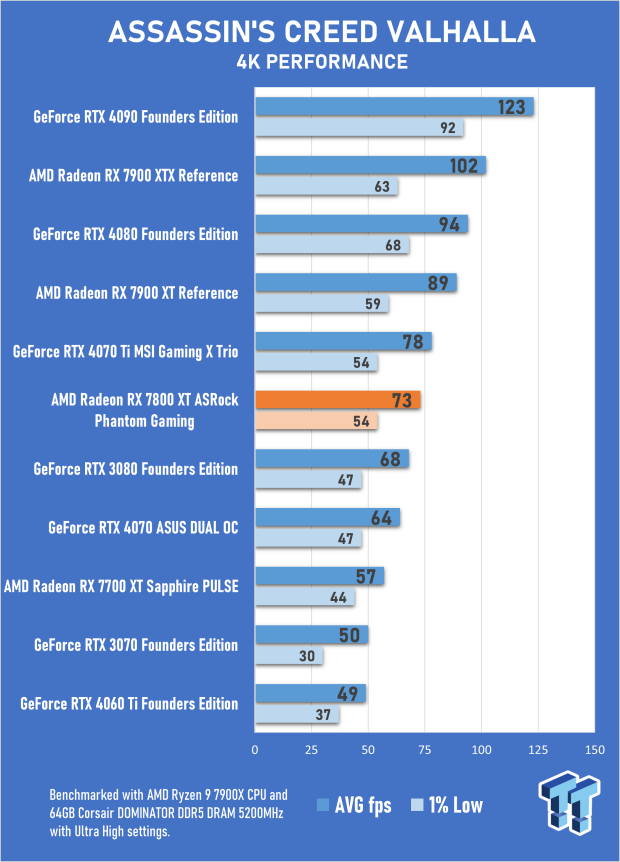
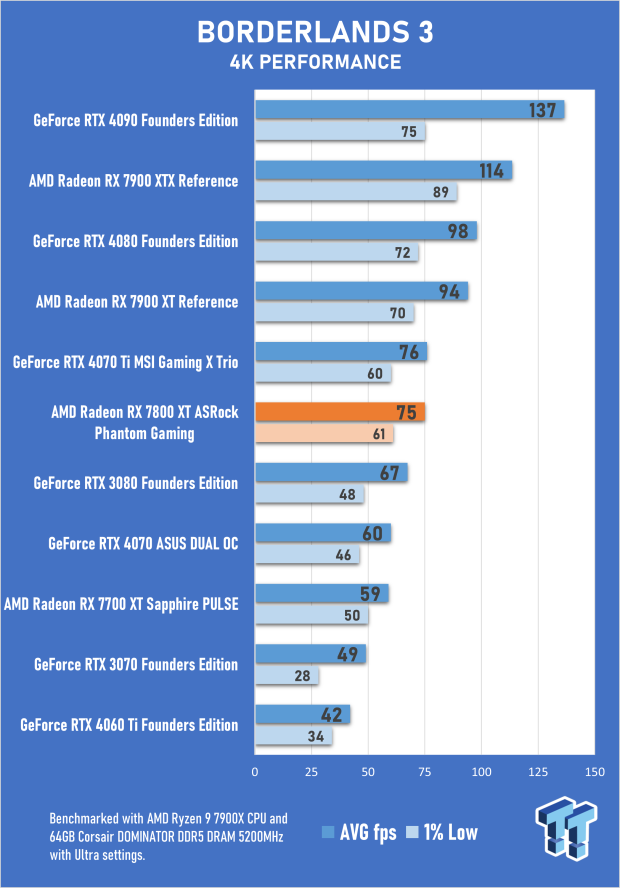
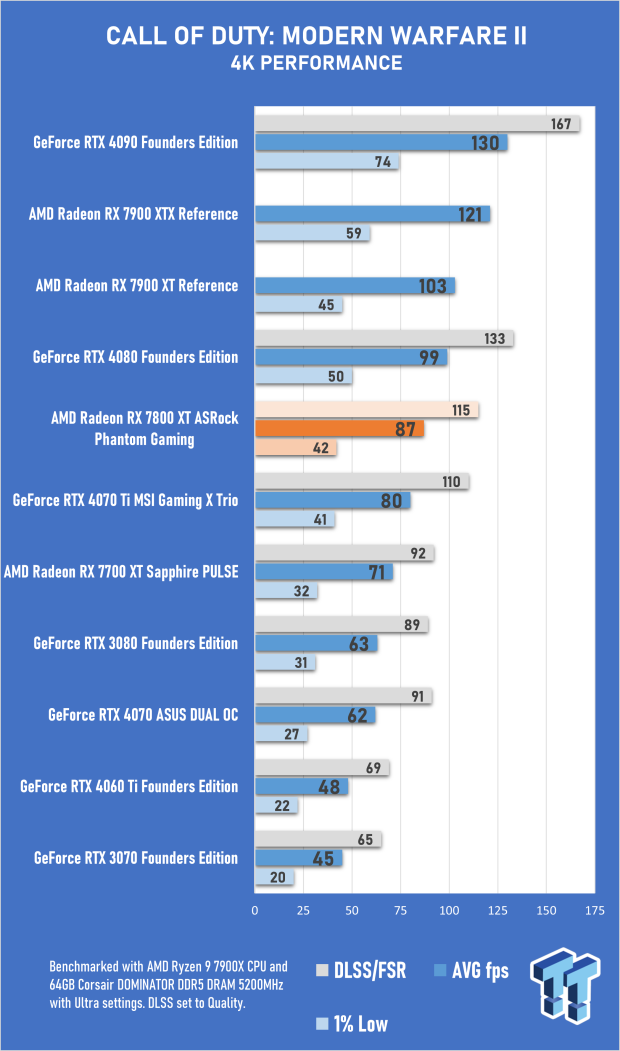
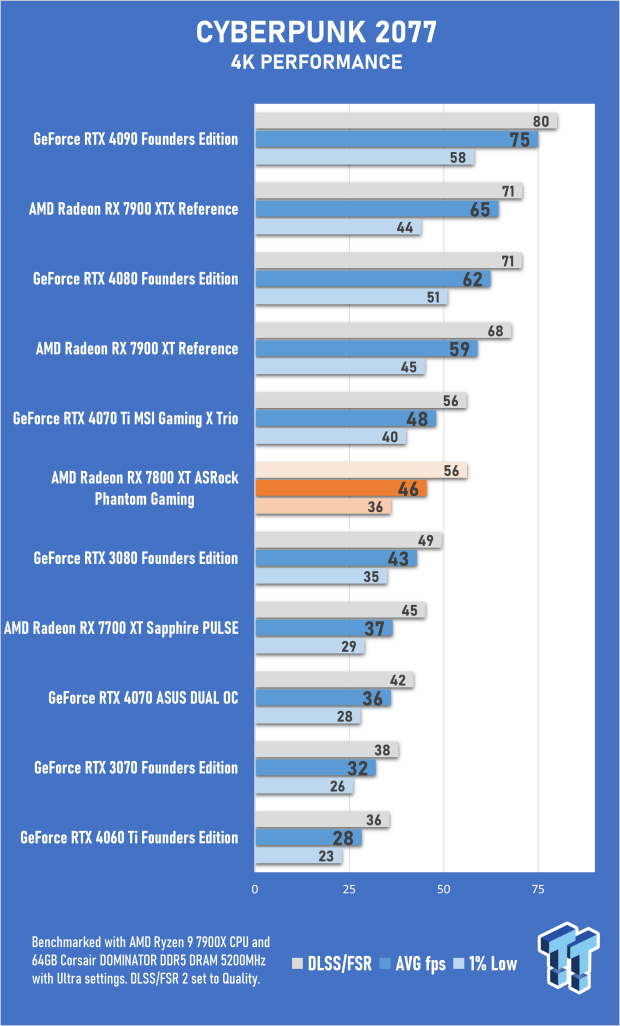
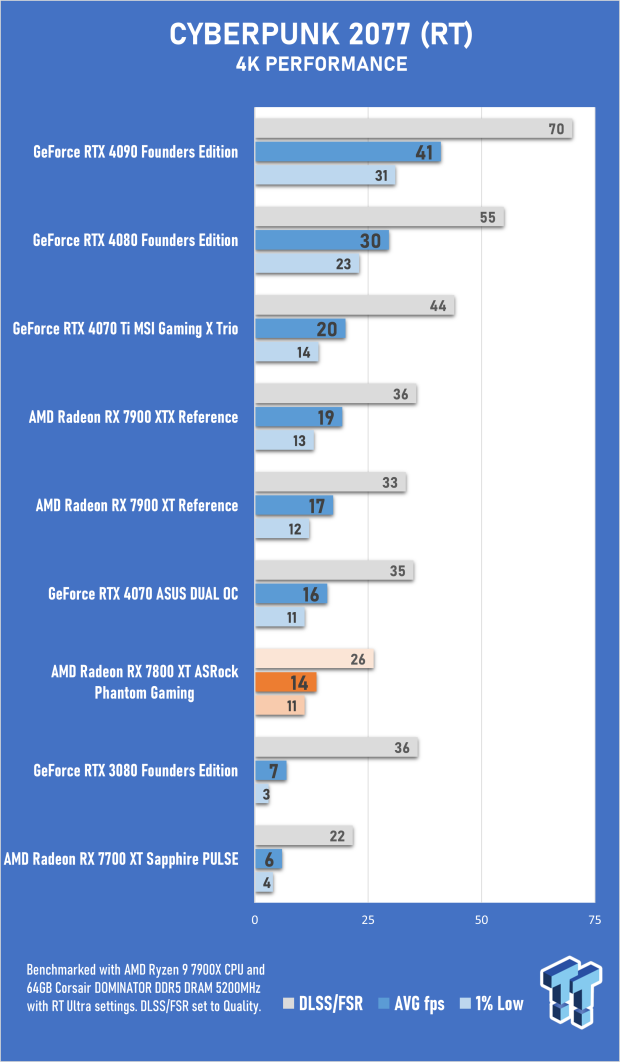
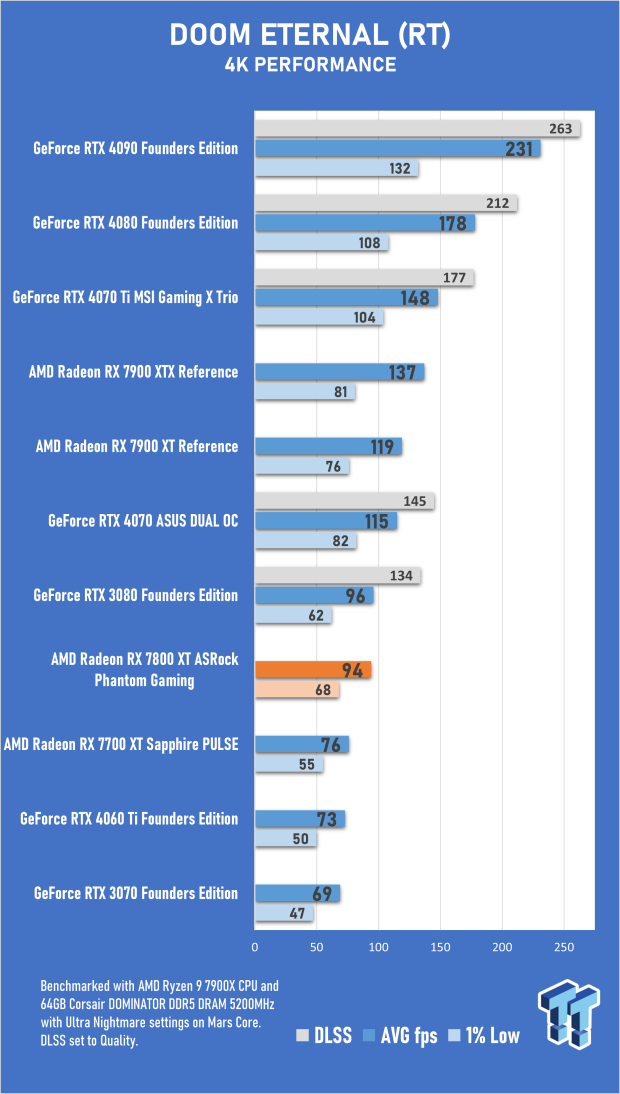
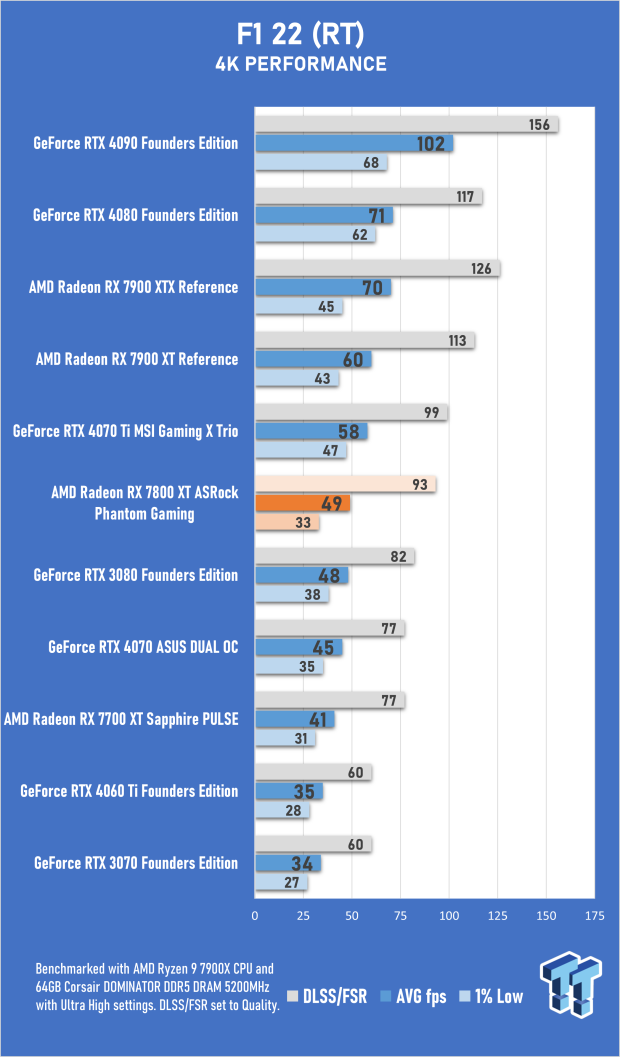
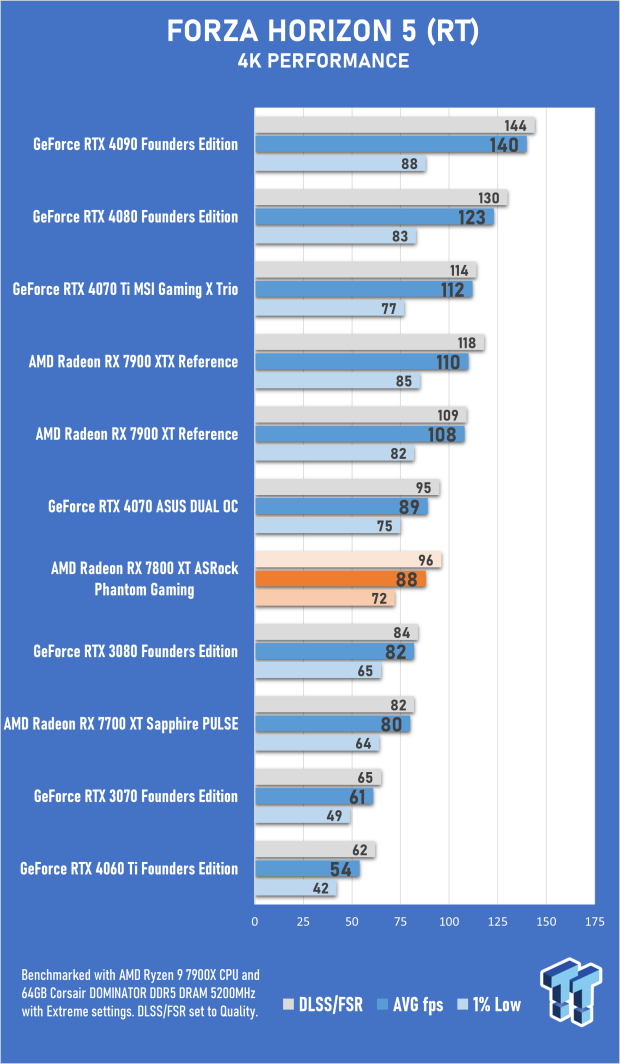
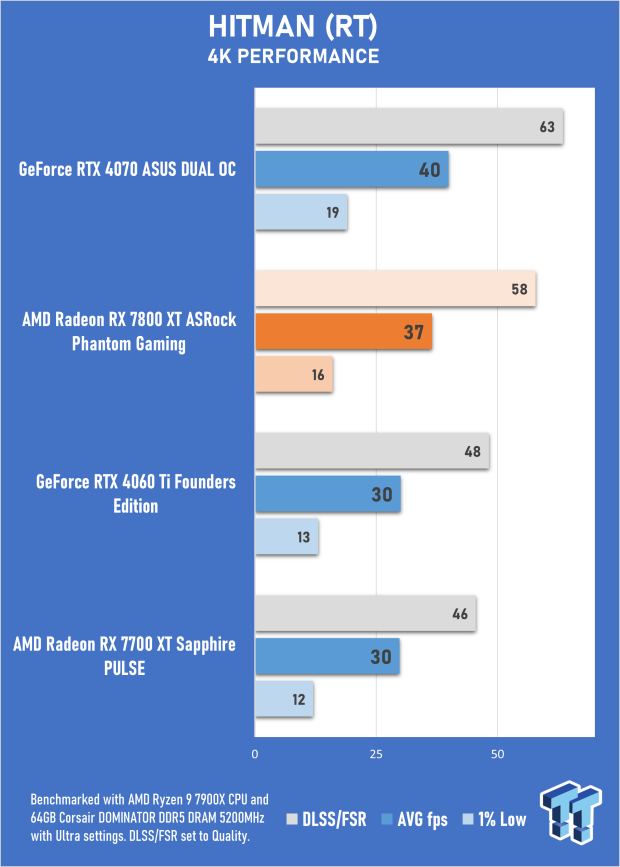
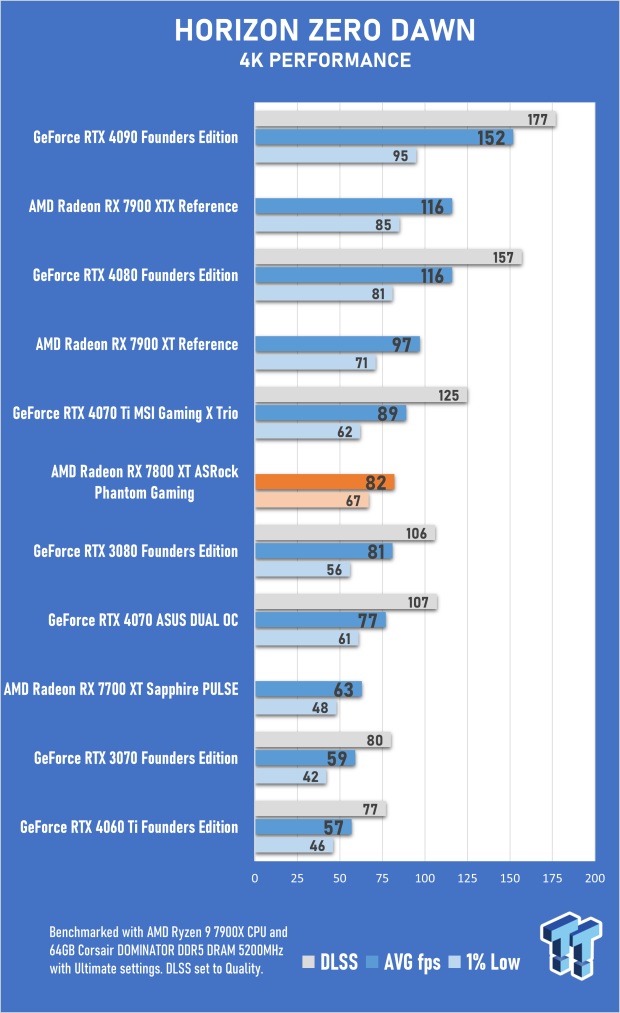
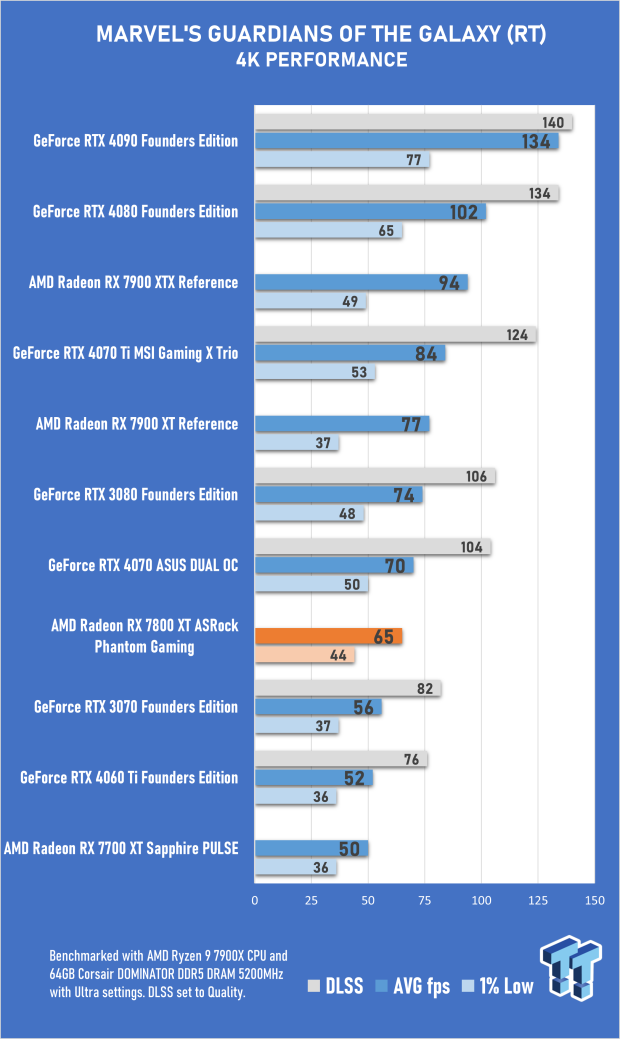
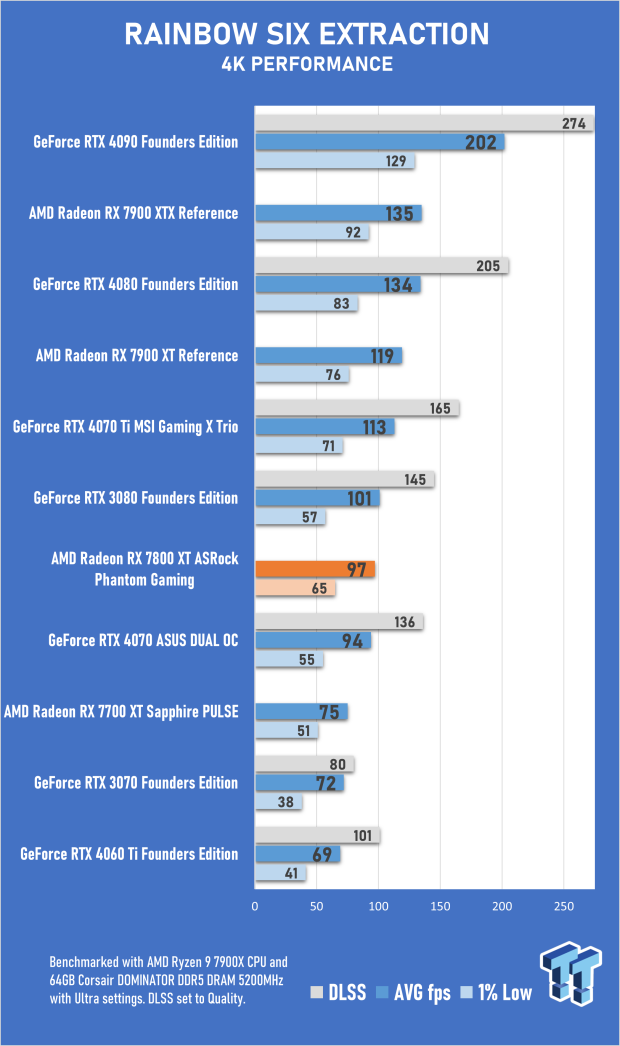
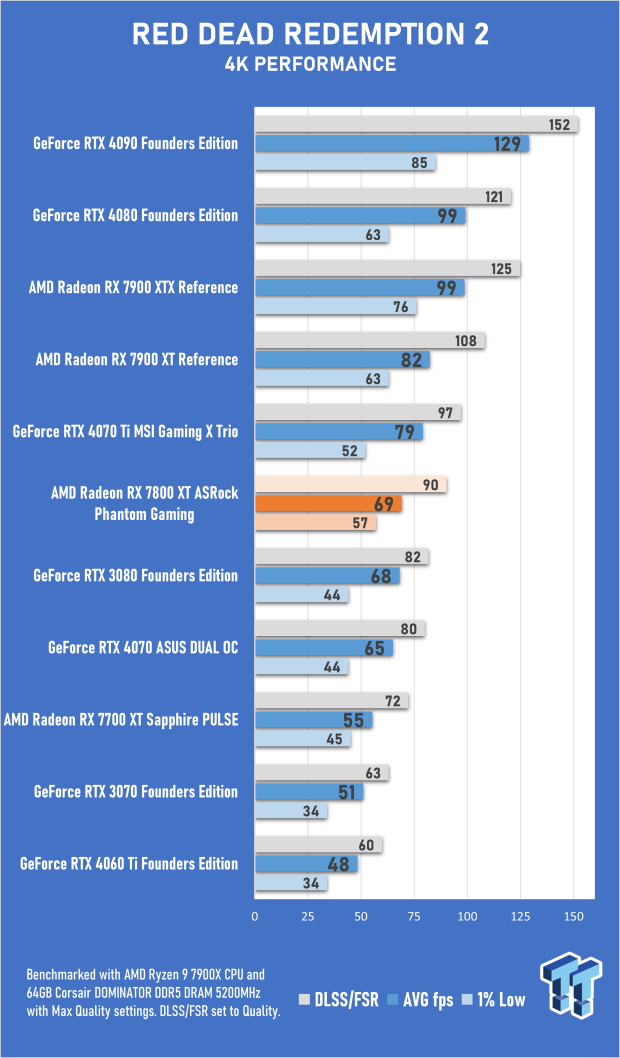
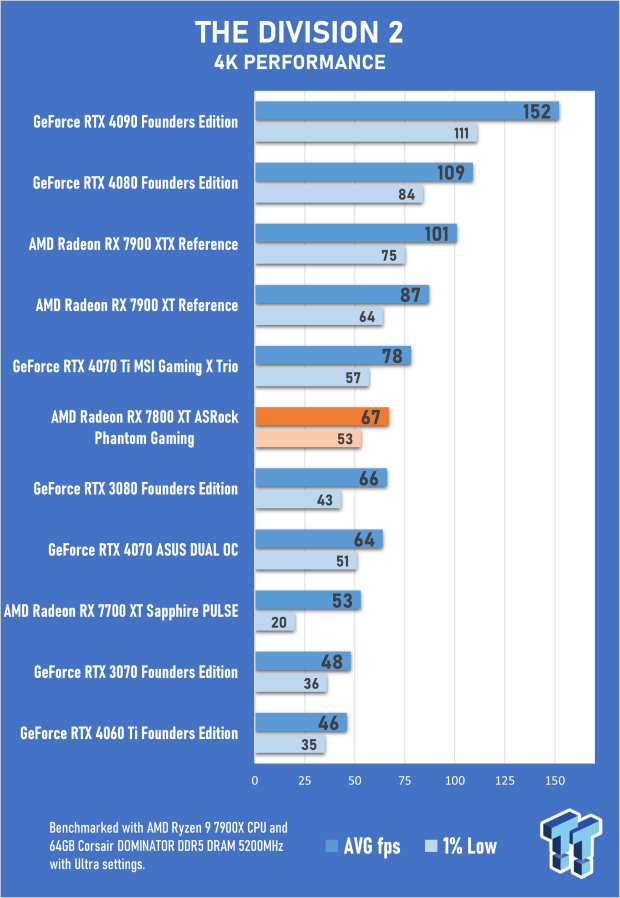
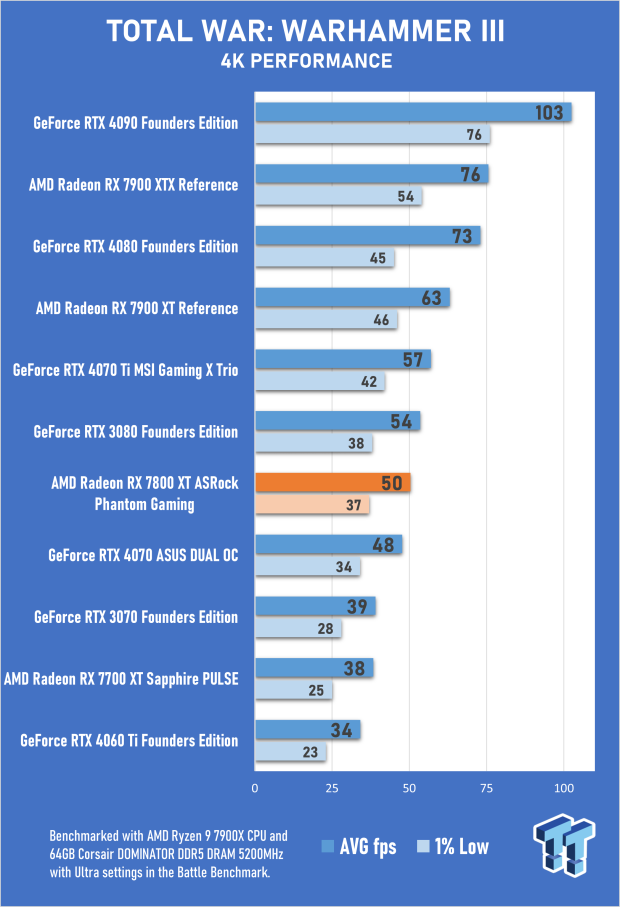
Benchmarks Summary - RT, FSR 2, and FSR 3
With its price point, the Radeon RX 7800 XT becomes an interesting successor to the Radeon RX 6800 XT, even though the performance difference is mostly negligible. You've got a competitively priced card with better efficiency than its previous-gen counterpart, and in 2023, that counts for a lot. This is the reason why the ASRock Radeon RX 7800 XT Phantom Gaming OC is going toe-to-toe against the GeForce RTX 4070 and not the GeForce RTX 4080 (which was the direct competitor to the Radeon RX 6800 XT). This is the context and the main reason why the Radeon RX 7800 XT is a compelling addition to the Radeon RX 7000 Series lineup.
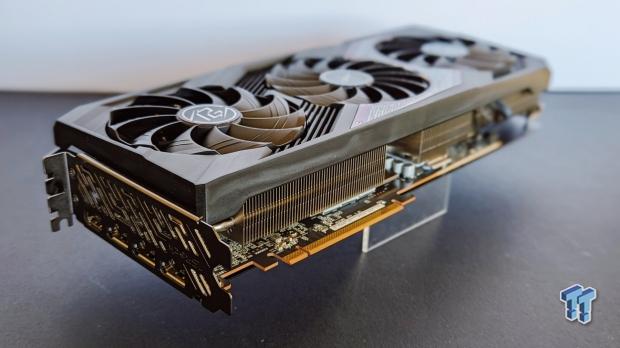
Looking at performance, the ASRock Radeon RX 7800 XT Phantom Gaming OC shines when it comes to 1440p gaming, and it's a capable 4K performer, too, depending on the workload. Ray-tracing performance might still be a step behind the competition (something that we've seen across all RDNA 3 GPUs), and AMD's FSR 2 still has a ways to go to match DLSS at 1440p - but the ASRock Radeon RX 7800 XT Phantom Gaming OC is impressive through and through.
Unfortunately, for this review of the ASRock Radeon RX 7800 XT Phantom Gaming OC, we haven't been able to test AMD's new FSR 3 technology and its Fluid Motion Frames feature that is the company's answer to DLSS 3 Frame Generation. Like FSR 2, it's open-source and will work with GeForce hardware and all Radeon GPUs. But with RDNA 3 exclusive features like Anti-Lag + for latency, we're keen to see its action and how it compares across generations and different hardware.
Temperature and Power Efficiency
Even though the entire RDNA 3 lineup is nowhere near as efficient as NVIDIA's new GeForce RTX 40 Series (which has shown unprecedented gains in this department), the Radeon RX 7800 XT is more efficient than the Radeon RX 6800 XT. But with performance generally being on par or close to the GeForce RTX 4070, it uses close to 30% more power when gaming than NVIDIA's card. Something worth noting.
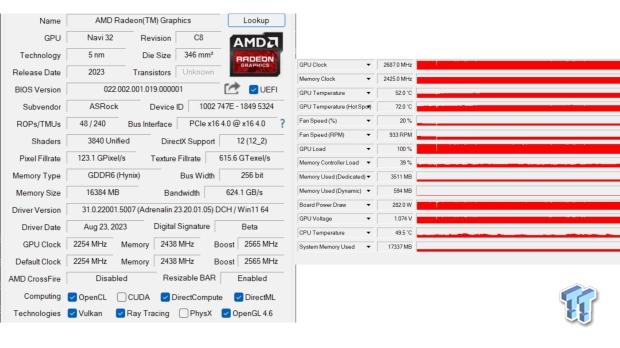
With a temperature of 52 degrees and a hot spot temperature of 72 degrees, the ASRock Radeon RX 7800 XT Phantom Gaming OC stays much cooler than AMD's reference 7800 XT. We saw it hit 72 degrees with a hot spot temperature of 91. Idle temps are lower, too, but what's remarkable is that at under load, the ASRock Radeon RX 7800 XT Phantom Gaming OC's fan speeds sat at around 20% capacity at around 930RPM, so it's very quiet even when being pushed.
Final Thoughts and Starfield
One of the big takeaways for the Radeon RX 7800 XT and the ASRock Radeon RX 7800 XT Phantom Gaming OC reviewed here is that you've got one of the most competitively priced GPUs for the current generation of hardware. Its 1440p performance is excellent, and the RDNA 3 architecture is much more creator-friendly than the previous generation. Adding to the value proposition, you get a copy of Bethesda's Starfield when you purchase a Radeon RX 7800 XT.
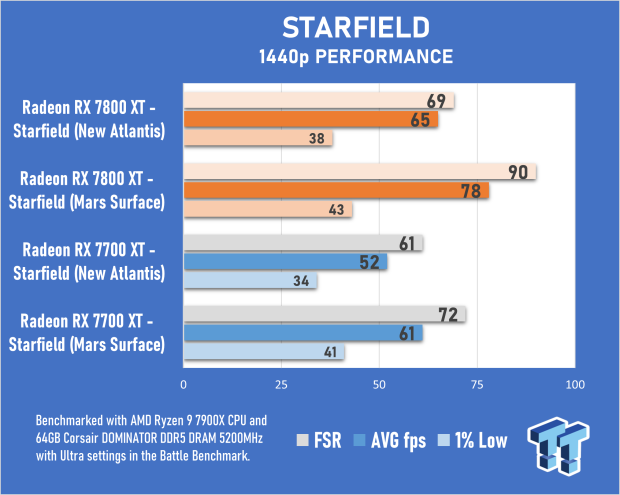
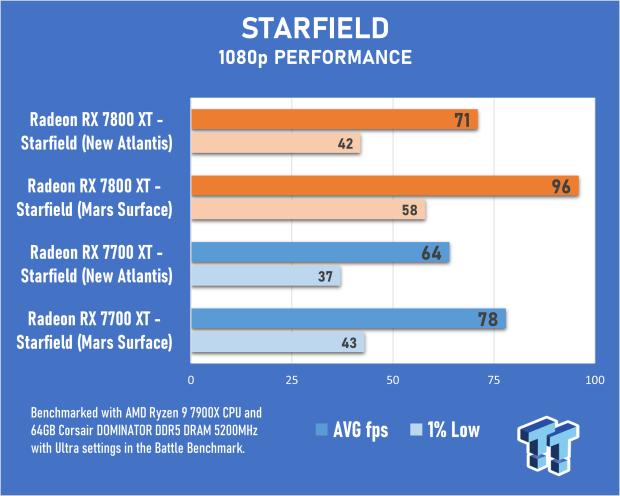
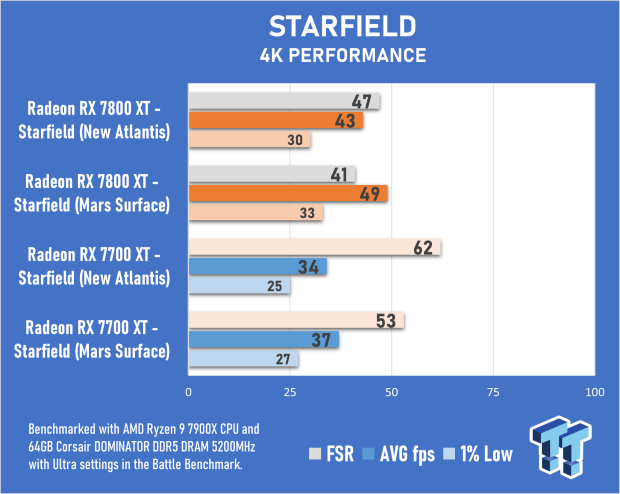
Starfield is a very intensive PC title when using the Ultra settings, but as you can see in the charts above, the ASRock Radeon RX 7800 XT Phantom Gaming OC is more than capable of running the game at 1440p - with or without FSR 2. AMD's upscaling tech at this resolution does impact visual quality, but it's worth enabling for a small performance boost and a more consistent greater-than-60fps presentation.
As far as Radeon RX 7800 XT models go, the ASRock Radeon RX 7800 XT Phantom Gaming OC's stylish design and exceptional cooling and thermal performance make it a clear choice over the reference design and something to consider if the price is right for you.

